Shimmering in infinite shades of blue are intertwined peaks and lush landscapes of green where 5 distinct island chains scattered across the South Pacific and 118 islands and atolls. As the birthplace of the overwater bungalow, French Polynesia is known as a haven for honeymooners but dig deeper and there’s so much more to this tropical paradise. This 2 week Islands of Tahiti itinerary provides a well-balanced perspective of the luxe and the affordable.
In this itinerary, you’ll learn how to plan your dream vacation to French Polynesia if you only have 14 to 16 days to work with. Inside, you’ll get inspiration on what’s the best way to hop through both the famous and off-the-beaten-path islands whether you’re on a honeymoon or seeking new experiences and adventure like we were. Most importantly, you’ll find detail insights on what you need to know before you go and tips on how to save money.
2 Week Islands of Tahiti Itinerary Highlights

This country deserves a proper amount of time to see but even then you will have only cracked the surface. This 2 week islands of Tahiti itinerary (16 days to be exact) features bucket-list worthy experiences that you’ll certainly need to consider as you put together your own vacation to paradise.
Here are the top 5 highlights from French Polynesia that made the trip truly epic!
- Le Meridien Bora Bora (now The Westin Bora Bora Resort & Spa)
- Diving with Dolphins
- Turtle Centre
- Wall of Shark
- Marché de Papeete
Read more about French Polynesia
- How to travel Bora Bora on a budget
- Ultimate Tahiti travel guide
- The Islands of Tahiti Packing List
- Complete French Polynesia Travel Guide
Budget stays on The Islands of Tahiti?
- You might be surprised to hear that there are many affordable accommodations in French Polynesia that aren’t the ultra resorts. On the main island of Tahiti, we stayed in an apartment unit that fit our needs perfectly. In Rangiroa, our pension or Tahitian guesthouse was less than $100 a night. In Fakarava, we stayed at Pension Paparara which helped us save money as well. For more ideas, I’ve compiled a list of the best pensions in Rangiroa and Fakarava.
Table of Contents
Looking for something specific in this French Polynesia itinerary? Jump straight to the section of interest.
In This Article
- 2 Week Islands of Tahiti Itinerary Highlights
- Table of Contents
- How To Plan A 16 Days Islands of Tahiti Itinerary
- Trip Planning Map
- Setting The Stage
- Day 1 – Tahiti – Loading Up On Supplies
- Day 2 – Tahiti – Island Tour
- Day 3 – Bora Bora – Arriving in Paradise
- Day 4 to 8 – Bora Bora – The Overwater Bungalow
- Day 9 – Bora Bora to Rangiroa – Real Tahitian Life
- Day 10 to 12 – Rangiroa – Tiputa Dolphins
- Day 13 – Rangiroa to Fakarava – A New Atoll
- Day 14 to 15 – Fakarava – Wall of Shark
- Day 16 – Home – Back to Reality
- Quick French Polynesia Travel Guide
- The Islands of Tahiti Itinerary Experience
- Travel Resources For Your Next Trip
How To Plan A 16 Days Islands of Tahiti Itinerary

If I rewind the tape and I think back on how this Islands of Tahiti itinerary came to be, I remember how overwhelmed and confused I was. How many days do I need here? I’ve heard of Bora Bora, but what other islands should I visit? How do the inter-island flights work? How can I make sure I don’t blow our budget? So many questions and not enough resources!
As you peel away all the layers, I can totally relate to you feeling equally as perplexed right now. The good news is that I’m here to help in the form of this fully broken down 2 week itinerary and French Polynesia travel guide.
As with all of my other itineraries, my goal is to help guide you through the trip planning process through my own. You can either copy it completely, take bits and pieces of it, or leverage my learnings to build an even better one.
Trip Planning Map
When I plan my trips, I always find that it’s helpful to visually see where everything is and this trip is no different from the 2 week Greek Island hopping, Egypt in 10 days, and 1 week in Austria itineraries.
With this map, you’ll be able to take this to go and have it ready for you on your phone or use it as part of your itinerary planning. I’ve always found this to be a nice quick-reference for when you travel especially for The Islands of Tahiti where you might have a few restaurants in mind that you want to eat at.
Tip: View the 16 day French Polynesia trip planning map in full screen and create a copy (this step is key) for yourself. Make tweaks for your own trip and in Google Maps, you’ll be able to view it by going into the menu, selecting “My Places” and the “Maps” tab.
BEFORE YOU CONTINUE
You need to read the companion French Polynesia travel guide that has literally everything that I learned from this trip. There are a lot of surprises that’ll hit you when you’re out there so you want to make sure you’re as prepared as possible.
Setting The Stage
For the purpose of this itinerary, I’m going to focus on the actual days in-destination and exc the transit days as well. Everyone is going to have a different route to get to French Polynesia so it’s not worth breaking that down. If you are looking for flight tips, you can find all of that in the French Polynesia Guide.
To give you an idea of my thought process when planning this trip, these were my 5 priorities:
- Stick to a budget which meant smart spending and not do anything ultra-lavish
- Scuba diving is some of the best in the world and so we weren’t going to miss out
- Leverage Marriott Bonvoy points accrued from my various Amex credit cards to stay at Le Meridien Bora Bora (now The Westin Bora Bora)
- Seek out affordable accommodations in Tahitian guesthouses
- Experience local culture by going off-the-beaten path and experience islands that most people skip
With that in mind, let’s dive (pun intended) into the 2 week islands of Tahiti itinerary.
Day 1 – Tahiti – Loading Up On Supplies

Since almost all international flights arrive in the evening, you’ll find it challenging to bounce away to another island right away. Instead of fighting it, I embraced it by planning a full 2 days on the island of Tahiti.
While I know some will tell you that there isn’t much to see on Papeete, I’d beg to differ so hear me out.
Read The Official Authority

If you’re looking for the authority on French Polynesia, look no further than the tourism board. It’s your resource for the breakdown on The Islands of Tahiti, the types of activities you can do, vacation packages, and a neat little game called “Pick Your Paradise” to show you how dynamic the country is. Click below to find your Tahiti specialist.

On your first day in Tahiti, jet lag will surely take hold. There’s no shame in sleeping in and and when you’re ready, head out to getting situated and stocked up. I know it won’t be the most exciting of days but you’ll be glad to have this one before you’re island hopping.
Tahiti, being the biggest of the islands, the most populated, and having the capital of Papeete means that things’ll be widely available and affordable.
TIP ON CAR RENTAL: In a game of indecision, I ended up cancelling my car rental with Hertz because I thought the combination of excursions and airport transfers with Tiurai Tours were enough. However, we quickly learned that based on where we were staying, we needed the freedom of a car to get around. Without it, we were restricted to walking. If you’re not staying in the city of Papeete, a rental car is highly recommended. More on car rentals in the travel guide.
Where you’ll go on your first day will largely depend on where you’re staying. If you end up at the Balcons du Lotus, which is in the neighbourhood of Punaauia, you’ll want to make your way to the Carrefour. There are 3 of these supermarkets on the island and this is the largest you’ll find.

At Carrefour Punaauia plaza, you’ll be able to run all of your errands. At Carrefour itself, you can buy breakfast, hot foods, groceries, souvenirs, and even last minute clothing purchases if you need them. Next to Carrefour is a pharmacy and so if you need mosquito repellent, this is your spot to pick it up. There’s a convenient store here where you can buy stamps so you don’t need to worry about it the rest of the trip for your postcards. You’ll also find multiple ATMs at this plaza so this is your chance to withdraw the local currency, Pacific Francs (XPF).
I’m going to re-iterate that this is going to be your best opportunity to stock up on supplies. Trust me when I say that you’re going to have a heck of a hard time buying these once you go to Bora Bora, Rangiroa, and Fakarava.
If you’re looking to exchange USD or EUR here, you’re better off doing it at the airport or in Papeete but keep in mind the day of the week you’re here because the banks and exchange centres are closed on the weekend. The only exception is Tahiti Exchange at the airport which is open 8AM to 11:30AM on weekends.
TIP ON MOSQUITO REPELLENT: I did some research before going to French Polynesia and someone recommended a French repellent named Moustidose. We used this throughout the trip and found it to be really effective. You will definitely need it on Rangiroa and Fakarava.
TIP ON ATMS: The ATMs in Tahiti are quite picky when it comes to debit cards. For my Canadian debit card, we couldn’t withdraw from Banque de Polynesia but had no problems with Office des Postes et Télécommunications and Banque de Tahiti. I’ve heard Banque Socredo is also easy to use. The other thing you need to know is that each has a different max limit.

For lunch, I recommend eating at Chocolatine which serves French brunch and Tahitian cuisine. They have an amazing benedict and tuna tartare.
The rest of the day is yours for you to discover the island and again will highly depend on where you’re staying.
For us in February, we were hit with pretty serious tropical rain so we ended up heading back to our apartment and taking it easy but if you’re interested in doing a bit more planning, here are a few ideas for the afternoon:
- Tahiti Sunset Cruise – A romantic 1.5 hour cruise with a maximum group of 12 and includes hotel pick-up and mocktail.
- Polynesian Dance Buffet – The Intercontinental Tahiti offers themed nights on Wednesday and Friday. To my surprise, there aren’t many places that offer a big experience like this.
- Roulottes Papeete Express – Typically this tour is for those arriving in Tahiti in the afternoon but this is an idea of something you can do in the evening which is to eat at the many food trucks (roulottes) in Papeete.
Day 1 Summary
Where you’ll eat:
- Lunch – Chocolatine – Fabulous cafe that serves a mix of French classics and traditional Tahitian dishes.
- Dinner – Carrefour Punaauia – There is a sweet selection of raw fish, fruits, and hot foods here that make great takeaway.
Where to stay:
The Islands of Tahiti isn’t all big resorts and underwater bungalows. What really surprised me about my trip here is how many guesthouse, apartment rentals, and B&Bs are available. This means that you have a lot of options available to you and many ways to save money.
WE STAYED HERE
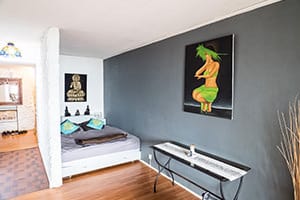
This is a unit in a gated residential apartment complex that is super private and complete with an ensuite bathroom and kitchen, making it a perfect apartment rental. It has a beautiful sunset view of Moorea from the window.
TAHITI LODGE
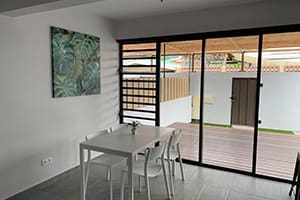
This is a super modern lodge with spacious rooms and shared bathrooms in Papeete. The rooms are a bit barebones but you get breakfast included and large lounge/kitchen area.
GUESTHOUSE IN THE CITY
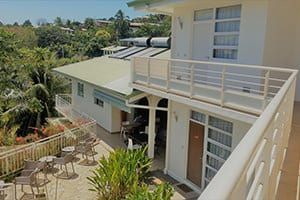
This is a lovely guesthouse in Papeete that is highly rated and very reasonably priced (under $100 USD). Guests have access to a shared lounge area and terrace to relax on. They also have free airport shuttle and free parking.
LUXURY
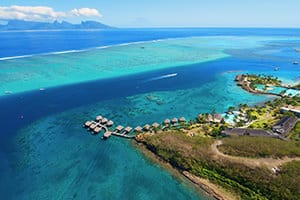
This is probably the best resort on Tahiti with a mix of overwater bungalows and traditional hotel rooms. The rooms are luxurious with excellent views and on-site is the highly rated Lotus restaurant, dive centre, and spa services.
Day 2 – Tahiti – Island Tour

You know why it’s a good idea to stay on Tahiti a little bit longer besides stocking up on supplies? Instead rushing off to other islands, spend some time to learn about the country’s discovery, history, people, culture, and food.
Start off your day with the breakfast supplies you picked up at Carrefour and then head out to get picked up by a local operator, Tiurai Tours. The owner, Vanessa, started her company in 2018 and her airport shuttle services and tours were highly recommended.
Your first stop on the tour is the city of Papeete. This is the centre of commerce on the island and an area that is most built up. The most famous thing to see here is the Marché de Papeete or also known as the Papeete Municipal Market. This is a two level hub for both visitors and locals alike. Tahitians come here to buy fresh vegetables and fruit on one end and on the other end, travellers walk through rows of stalls where oyster shells are repurposed into beautiful works of art and the fragrance of tiaré fills the air.

This market is at the core of your Tahitian orientation experience. During your time here, your guide will show you all of the local creations, explain what manoi oil is, see how leaf purses are made, look closely at hand-made Polynesia pareo (wraparound skirt), and small different forms of fresh vanilla.
Continue your walk around and you’ll discover where you can buy fresh flowers, pick up hot foods to go, and fresh market vegetables and groceries.

Something you should definitely ask for is to try of the unique food items you can find in the market such as sweet potato, taro, breadfruit, cooked banana, and cooked fei’i. Another thing to look out for is taota which is dessert that almost resembles mochi but is actually a root vegetable that has caramel and tapioca-like qualities when baked.
There’s more to discover upstairs and also surrounding the market on the outside. This is your chance to buy souvenirs. It may seem counter-intuitive since it’s at the beginning of the trip but trust me, the prices here are significantly cheaper than if you decide to buy something at your Bora Bora resort. In fact, we found it quite challenging to buy postcards and magnets once we left Bora Bora and had to resort to picking these up at the airport shop.
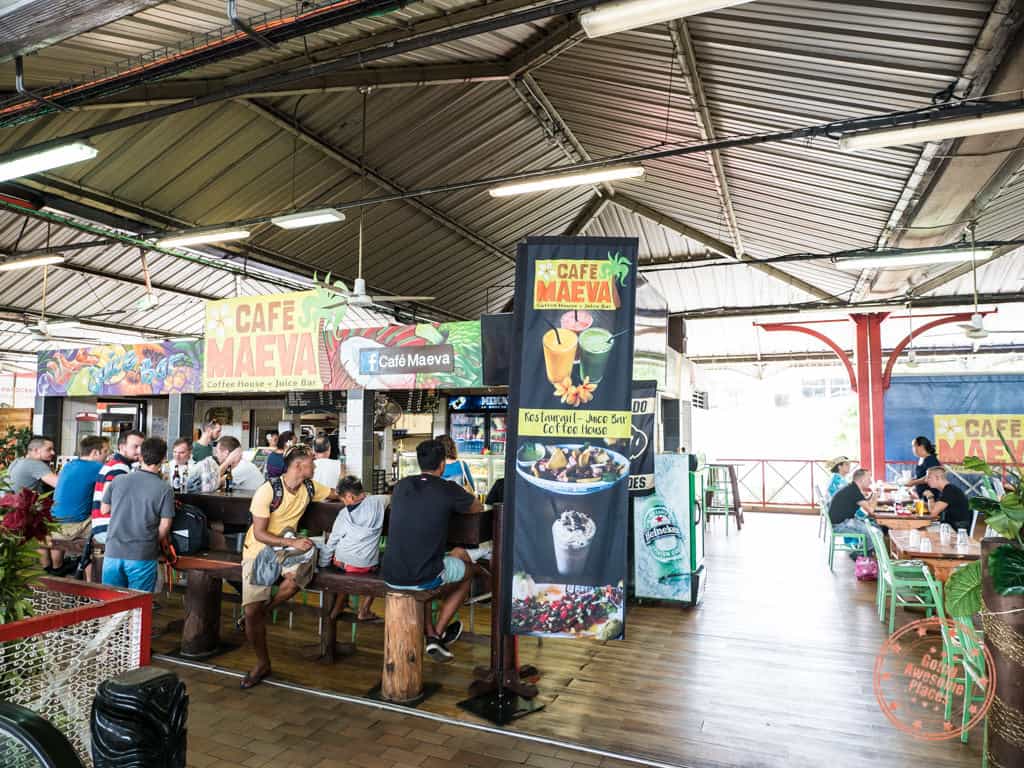
For lunch, you’ll eat at Café Maeva. Located on the second level of the market, it has laid back vibes written all over it with its bar tabletop and open table seating. With access to the freshest ingredients and amazing chefs, don’t let the casual island environment fool you, the traditional Tahitian food here is done to perfection and I can’t recommend them highly enough.
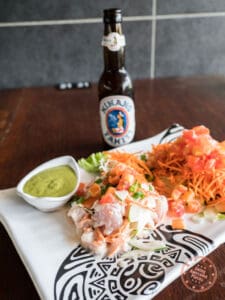
While you’re here, make sure to have the poisson cru au lait du coco. Poisson cru is emblematic of Tahitian food and diet with a mix of fresh tuna, a twist of citrus, fresh vegetables, and coconut milk. This’ll help you set the bar for what good poisson cru tastes like. Their grilled fish of the day and tuna trio is also excellent.
WHAT YOU NEED TO KNOW
Address: 23 Rue du Père Collette, Papeete 98714, French Polynesia
Hours: Monday 5AM – 5PM, Tuesday to Friday 4AM -6PM, Saturday, 4AM – 4PM, and Sunday 3AM – 9AM.
Price: No admission for entry.
Tips:
- The market is broken up into different sections. You have the souvenir block of stands, fresh flowers, groceries, food court vendors, and souvenir shops upstairs.
- Maybe I didn’t look that hard but it seemed like the main restaurant upstairs was Café Maeva and from the lunch that we had with them, I was very impressed with their food and would recommend them for lunch.
- You can do the market for free especially if you’re staying nearby but it is helpful to have a local walk you through the market. I liked that we could ask questions and particularly appreciated that she bought a sample platter of sweet fruits and vegetables that are staples of Tahitian diet.
- This market is probably one of the better places to buy souvenirs. There’s a souvenir shop upstairs and that’s where we picked up our postcards, Marquesas tiki, magnet, patch, and sticker for all the things I collect when I travel.
- For Café Maeva, you don’t need reservations but if you want to play it safe, you can make reservations for a table once you get to the market and eat lunch after you’re done exploring the area.
- Lunch is not included with the tour.
Besides the overwater bungalow, the Tahitian black pearl is perhaps the country’s most famous export. What makes these pearls so well-known (and expensive) is that they’re the only pearl that has a mesmerizing dark charcoal shimmer. In fact, these pearls make up 55% of the country’s exports and are almost exclusively cultivated in French Polynesia through a special process.

After lunch, head out of the market and walk over to the Tahiti Pearl Market. They’re one of the largest sellers of Tahitian pearls and is a great place to see, learn, and touch these rarities. Unlike other stores, they have an immersive shopping experience where you get to hand-pick the pearls and watch them place it into any setting you wish.
In the palm of your hands can be a pearl worth $10,000 USD. Even if you don’t buy anything, the sales reps there are more than willing to explain the different grades of quality, differences in colours, and answer our questions about how cultivation works.
TIP: Bring your own water. One thing we noticed with most tours on Tahiti is that they don’t provide a free supply of water.
There’s much to explore on the island so it’s time to hit the road!
Back in the van, you’ll start making your way clockwise to the eastern part of Tahiti. The first stop is Venus Point, the northernmost place on Tahiti. The name comes thanks to Captain James Cook who originally came to this point to study the movement of Venus across the sun.
Here, you’ll find Tahiti’s only lighthouse (Teara o Tahiti) that dates back to 1867. Surrounded by a beach of black sand, you’ll also see examples of original Polynesia canoes named va’a, and a park-like setting for locals and tourists swimming, surfing, or learning about Polynesian history.

Next, you’ll make your way to the Arahoho Blowhole. Formed from battering surf, cutting into the basalt shoreline and eroding a passageway, eruption of dragon’s breath steam surprises visitors that walk by.
Beyond the blowhole, you can also walk along the pathway that wraps around the coast where the old road followed before the tunnel opened.

From the blowhole, you’ll make a short drive to the Faaurumai Valley near Tahiti’s north coast. Nestled in the thick rainforest are three different waterfalls but only Vaimahutu Falls is currently open and easy to walk to. After a short 5-minute walk, you’ll arrive at the large pool of water that catches the 100 feet cascade. After a rainy day, the power of the waterfall can be heard and felt.
On the way back home, you’ll make one final stop at the Tahara’a Lookout (Belvedere du Tahara’a) which has panoramic views of Papeete.
Dinner at the Papeete Roulottes (Vaiete Roulottes) is a great option and one of your only chances to do this before you head off to the other islands. Every night, food trucks converge on this spot and is a great way to sample many different types of foods from crepes, Chinese, burgers, Tahitian, and more for affordable prices. Officially the hours for the roulottes is 6PM to late but my recommendation is to arrive after 6:30PM once they’re all set up.
TIP: Think about what your dinner plans are especially if you’re not staying in Papeete. One idea is that you can have dinner at the Papeete Roulottes and then cab home. Alternatively, you can also look at other individual food trucks around the island that’s closer to your accommodations. Also keep in mind that roulottes only take cash.
There’s so much more that you can do on Tahiti and we considered many other options before deciding on something a bit more laid back. Instead of doing the east coast island tour that we did, here are a few other alternatives that you can take a look at.
- Scuba Diving with TOPDIVE – Yes, Tahiti actually has really great diving and TOPDIVE is one of the go-to dive shops that runs out of the Intercontinental. Keep in mind their great bundling pricing that they have.
- Papeete Inner Island Full-Day Jeep Safari – A highly raved about experience is the jeep safari that takes you into the interior of the island and the crater in Papenoo Valley that you can only get to by a 4×4.
- Tahiti Island Tour Including Venus Point, Taharaa View Point and Vaipahi Gardens – This is a great 4-hour tour that takes you out to see some of the primary sights on the eastern coast.
- Half Day Tahiti Tour – This is a half day tour that has two time slots (8AM and 1PM). Van has AC, wifi, and informative guide are included.
Day 2 Summary
What you’ll see:
Where you’ll eat:
- Breakfast – Breakfast food from Carrefour.
- Lunch – Café Maeva – Superb restaurant located in the Papeete Market with Tahitian dishes in a relaxing environment.
- Dinner – Papeete Roulottes – Has a feel of an Asian hawker centre with many food trucks lining the harbourside square. Food is cheap and plentiful. Go for the atmosphere, location, and low prices.
Day 3 – Bora Bora – Arriving in Paradise

It’s finally time. Pack your bags and pump your fists in the air because it’s time to make your way to Bora Bora!
Depending on your flight time, you’ll get a pick up from a service such as this one. Since this is a domestic flight, you’ll only need to be at the airport at most 1.5 hours before take-off.
PACKING TIP: Air Tahiti is quite strict with check-in and carry-on weight, and number of bags on departures from Tahiti so be careful here. Remember, it’s 23kg for check-in, 5kg for carry-on, and only one carry-on bag is allowed (full rules here). The only exception seems to be for those that are travelling with a lot of camera gear. I was clearly over on my carry-on weight in my Peak Design Travel Backpack but they allowed the overage. You’ll be given pink carry-on tags upon check-in.
If you didn’t do this on initial arrival in French Polynesia, this is your last chance to decide whether you want to have a pocket wifi device with you or SIM card. In the car rental section of the airport is Tahiti Wifi. They are the only vendors that have hotspots at the airport. Head to The Islands of Tahiti travel guide for full details on this including pricing and whether it’s worth it or not.

FLIGHT BOOKING TIP: There’s really no reason to linger in Tahiti on this day so I recommend that you take one of the early flights to Bora Bora. This way, you can maximize your day there even if your room isn’t ready.
When you arrive at the airport, head to the Air Tahiti check-in counter which is on the left-most side of the airport. Remember that this is domestic flight so there is no security that you have to go through. Once you have your boarding pass, you’ll literally walk into the gate area.

WATER TIP: No security means no liquid restrictions. Feel free to pack water with you!

Another thing you should know is that Air Tahiti is has open seating so when they announce boarding, get in line as seating is done on a first-come-first-serve basis.
BEST SEAT TIP: Once you get on the plane, ask the flight attendant about which side you should be on. From my experience, the left side is where you want to be but double check because the approach may be different for some reason that day. For where to sit on the plane, if you want unobstructed views, either sit in the first 3 rows or the last 3 rows. Anywhere in the middle you’re going to have the wing and/or engine in view.
Your flight to Bora Bora will be a quick 50 minutes and the view of the resorts and Mount Otemanu will be remarkable.
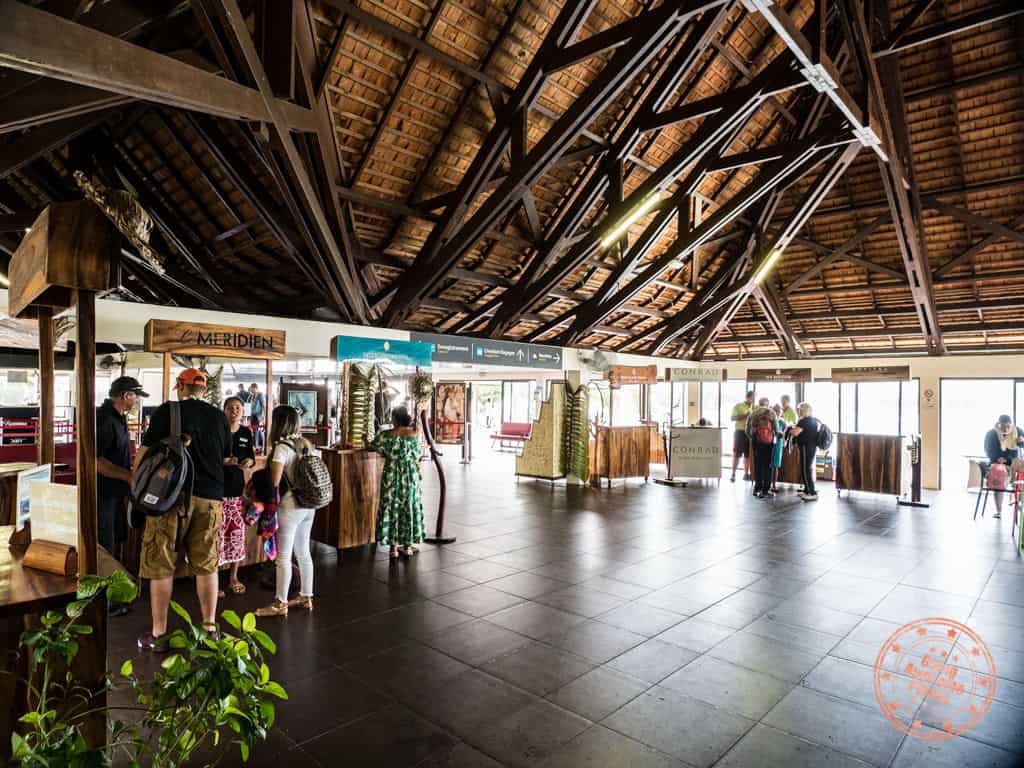
NOTE: The Le Meridien Bora Bora underwent extensive renovations and is now rebranded to The Westin Bora Bora Resort & Spa.
When you arrive at the airport, you’ll walk immediately into an arrival area that’s surrounded by small stands of all the big resorts on the island. You should be able to spot yours quickly. In our case, it was the Le Meridien Bora Bora stand. You will be greeted with beautiful leis and given resort tags. You’ll be instructed to get your luggage and hand them over to the staff for loading onto the boat.

There is no baggage carousel on these island airports. Instead, they have a two-tiered metal rack where they throw the suitcases onto. All the passengers surround these racks and you grab your bag when you see it.
The Le Meridien staff will grab your bags with the tags once they spot you and from there you’ll seamlessly exit the doors of the airport and onto the jetty where the boat will be waiting for boarding.
You’ll be likely arriving with a bunch of other new guests to the resort from Tahiti. Everyone will board the boat and before you know it, you’ll be whisked away.

A welcoming committee will greet you, complete with ukulele performance and staff waiting to help you off the boat and get you sorted. Each staff member will be assigned to a couple of guests and you’ll split you off into different parts of the resort reception level.
There are a lot of need-to-know’s here about Le Meridien Bora Bora. Make sure to read the full review of the resort and the overwater bungalows if you’re interested in knowing the helpful details.

Led to the Miki Miki Bar, our check-in specialist, Kayo, gave us welcome drinks, a cool towel, and went off to print some of our paper work while we provided her with our passports and credit card. I had to fill and sign on the indicated areas and the last remaining thing was confirming what I wanted as my reward amenity for my Platinum status. Naturally, I said the complimentary breakfast.
Once you get the paperwork in order, your specialist will show you a quick tour of the property and point out its key features. I’ll say that it’s pretty brief so you’ll need to dive in yourself to find out what kind of activities you can book and what is free. Luckily for you, I’ll be writing a review of the property to help you plan your stay here. Le Meridien unfortunately doesn’t do a great job at guiding you through this.


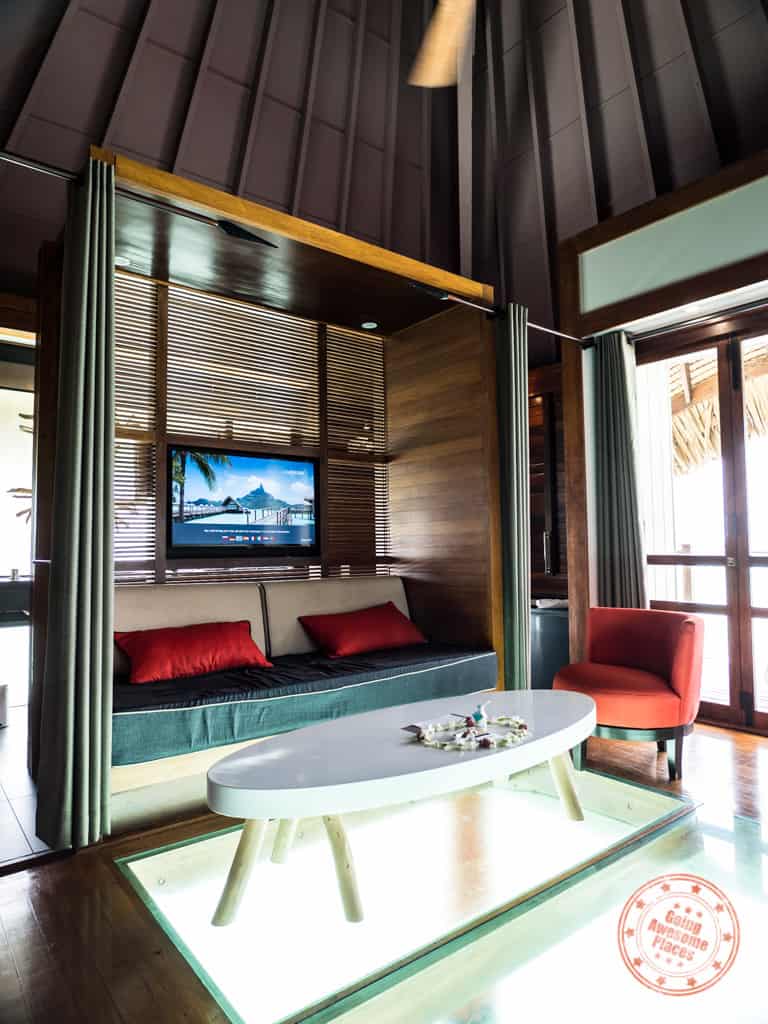

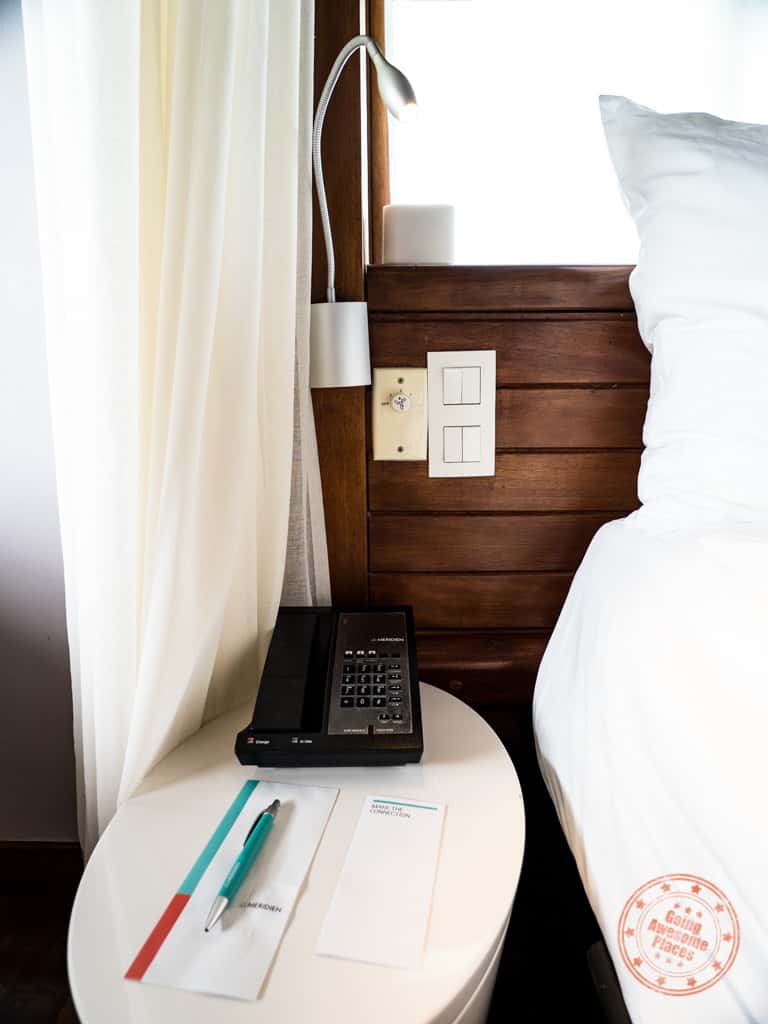

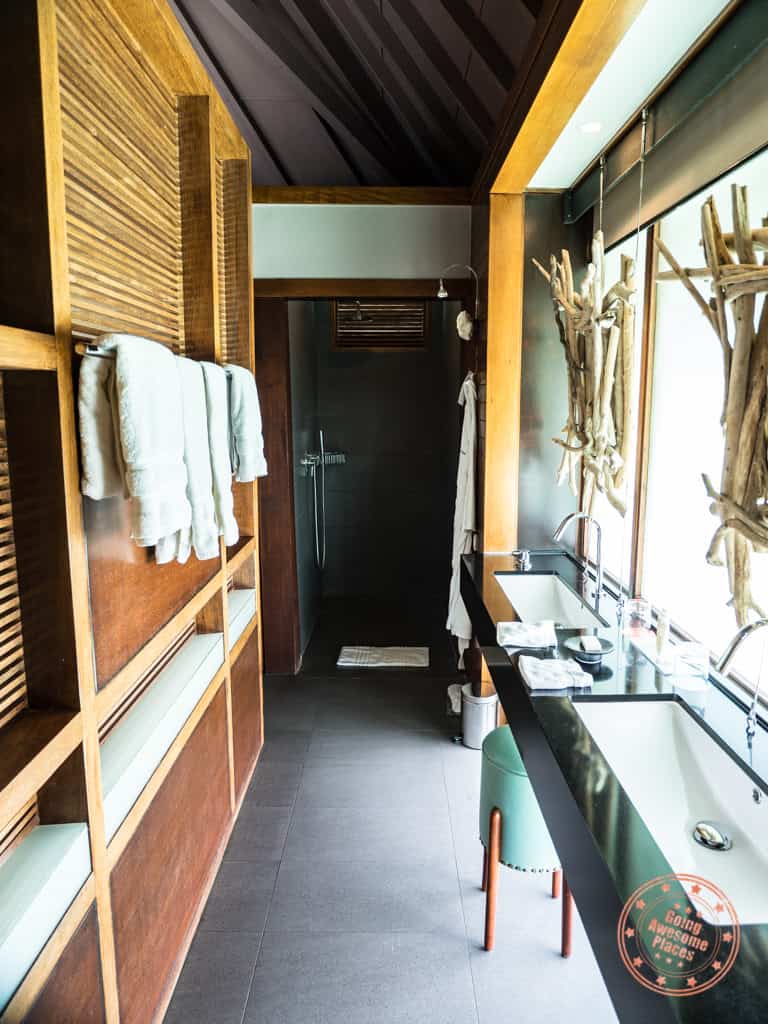
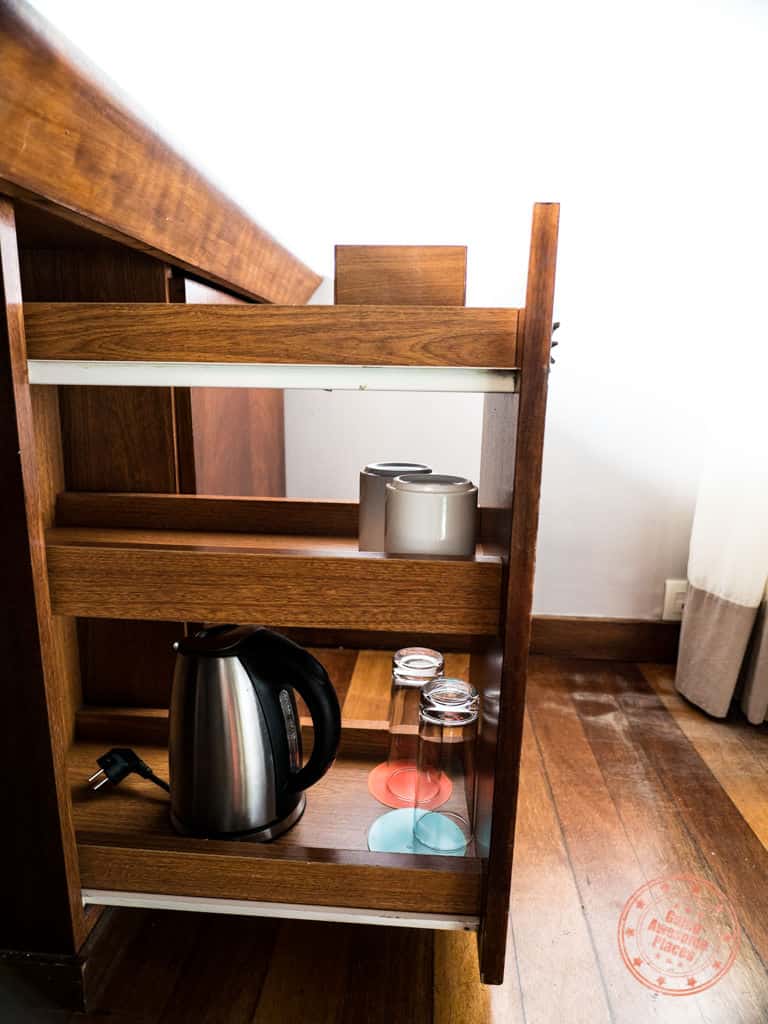
Despite arriving early, there’s always still the chance of getting your room early as we did. We expected to get our room by noon but to our pleasant surprise, our room was ready right after the tour and this was at roughly 10:15AM.
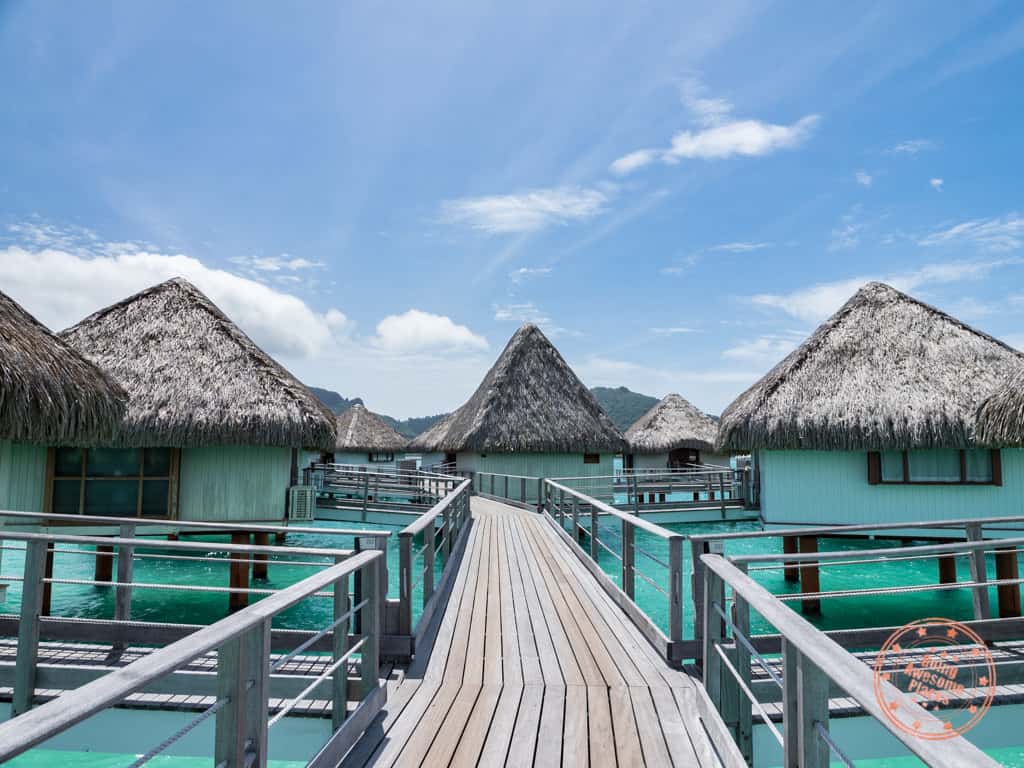
For the rest of your first day, you’ll be giddy with delight. After you get settled in and gawk at how large the glass-bottom floor is and how ridiculous the balcony view is, you’re free to do anything you want.

In fact, I’m not really going to do much guiding beyond this for the rest of your time at Le Meridien Bora Bora because this is your vacation.
If there’s any recommendation I’m going to make, it’ll be to take the afternoon to go to the concierge and flip through activities in the book/iPad, check out all of the restaurant menus, ask about all the special days if you haven’t read the property guide so you can make a plan for your stay.
Day 3 Summary
Where you’ll eat:
- Breakfast – Breakfast food from Carrefour
- Lunch – Skipped – We were overwhelmed by excitement that we didn’t end up eating a proper lunch at Le Meridien and instead snacked on some bars we brought.
- Dinner – Miki Miki Bar – You’ll quickly learn that the pizza here is phenomenal and the best value item at the resort.
Where to stay:
Undoubtedly an important decision here because it’ll have a huge impact on your experience since this is your longest stay and most expensive as well. I’m biased towards the Le Meridien Bora Bora because I was able to leverage my Marriott Bonvoy points for this stay but I can equally argue this for many of the other Bora Bora properties. Here are my recommendations.
WE STAYED HERE

While I will say it’s half a star away from the top luxury resorts, for the points and cash you have to spend to secure a reward stay here, you really can’t beat Le Meridien for its strategic position in Bora Bora and amazing views of Mt. Otemanu.
BUDGET
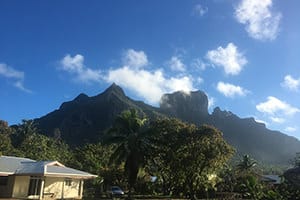
This is a Tahitian guesthouse and perfect for those wanting to a local/budget experience. This property is located by Matira Beach, main town centre, and the dock. Pick up is free from the airport.
MID-RANGE
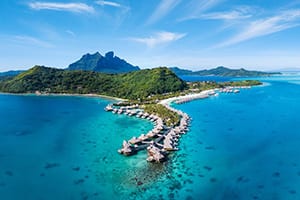
Cream of the crop of properties in Bora Bora and a top choice for anyone with Hilton Honors points. Price wise, they’re actually comparable to Le Meridien surprisingly. Suites are massive but only knock is that it doesn’t have Mt. Otemanu views.
BEST
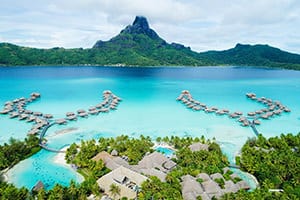
This 5-star resort is arguable the top property in Bora Bora. From the massive suites, the amenities, the spa, restaurants, and private beach, everything is of the highest standard. The staff will often go out of their way to make sure you’re taken care of.
Looking for deals?
Current Travel Deals
Day 4 to 8 – Bora Bora – The Overwater Bungalow

With 6 nights to work with, there’s plenty of time to enjoy the resort and Bora Bora as well.
Below are a few things that we did during our time at Le Meridien to give you a few ideas in this Islands of Tahiti itinerary.
You’ll quickly learn that with the right planning, you can definitely do Bora Bora on a budget.
Snorkelling

There are two main snorkelling areas on the property.
The first is right below your overwater bungalow if you’re closer to the beach where the water is only waist high. There isn’t that much to see since there isn’t a house reef like the one at Conrad Maldives but there are fish that hang around the bungalow support stilts and also by to the dock area. You can also snorkel all the way out to the main beach area but since it’s almost all sand, you won’t find too many fish there.
The second is the inner lagoon. There’s more to see here because of a couple of reasons:
- There is a cluster of tikis underwater and those are fun to find.
- At breakfast, they hand out fish food to guests and so that actually attracts a lot of fish to Le Tipanie part of the lagoon.
- Near the chapel are a few coral growing stations and this is the same water that leads into the Turtle Centre’s pool. Fish have access in and out through an open part of the mesh so more fish are naturally in this area.
We initially thought there would be good snorkelling near the secret cabanas but it’s way too shallow there.
Resort Activities
From the activity centre, there are quite a few activities that you can do. Most are free and some are paid.
Free Water Activities

- Snorkel rentals
- Glass bottom single and double kayaks
- Paddleboards
- Polynesian sailing canoe – 30 minute beach discovery
Paid Water Activities
- Kite surfing
- Waterski, wake board, tube tow, surf foil
- Va’a ho’e outrigger canoe experience
- Hobie cat
Lastly, if you’re looking for activities on the beach, there are a number of free activities you can take advantage of:
Free Land Activities
- Beach volleyball
- Football (soccer)
- Badminton
- Giant chess
- Lawn bowling
- Pool
- Ping pong
Special Resort Events

These aren’t well promoted by the resort but there are a couple of free events that are sprinkled throughout the week.
- Wednesday – Movie Night on the beach
- Thursday – Polynesia Dance
- Saturday – Beach Party
Secret Cabanas

These probably aren’t the official names for these and they’re not even on the official map but they must be part of the property.
This is one of those things that isn’t promoted on the property which leaves guests skeptical to go since it’s across lagoon waters.
I highly recommend anyone staying here because it’s incredibly secluded and is a near-private part of the resort because nobody goes. These are 4 cabanas placed right above the water, allowing you to lie down on a suspended bed with only the rustling of palms and crashing of the ocean on the other side of the lagoon.
Beach

There is a large stretch of beach that connects the two sides of the resort and faces the Bora Bora lagoon and Mount Otemanu. This has to be one of the best features of the property because not only are the views breathtaking, but the waters are incredibly shallow, the white sand soft, and the perfect temperature.
The beach has many types of chairs for you to enjoy depending on your lounging style or you can swim out to the floating blue rings that are anchored in the water. They allow you to stay cool with the water while still getting a great tan.
Sunset Photos
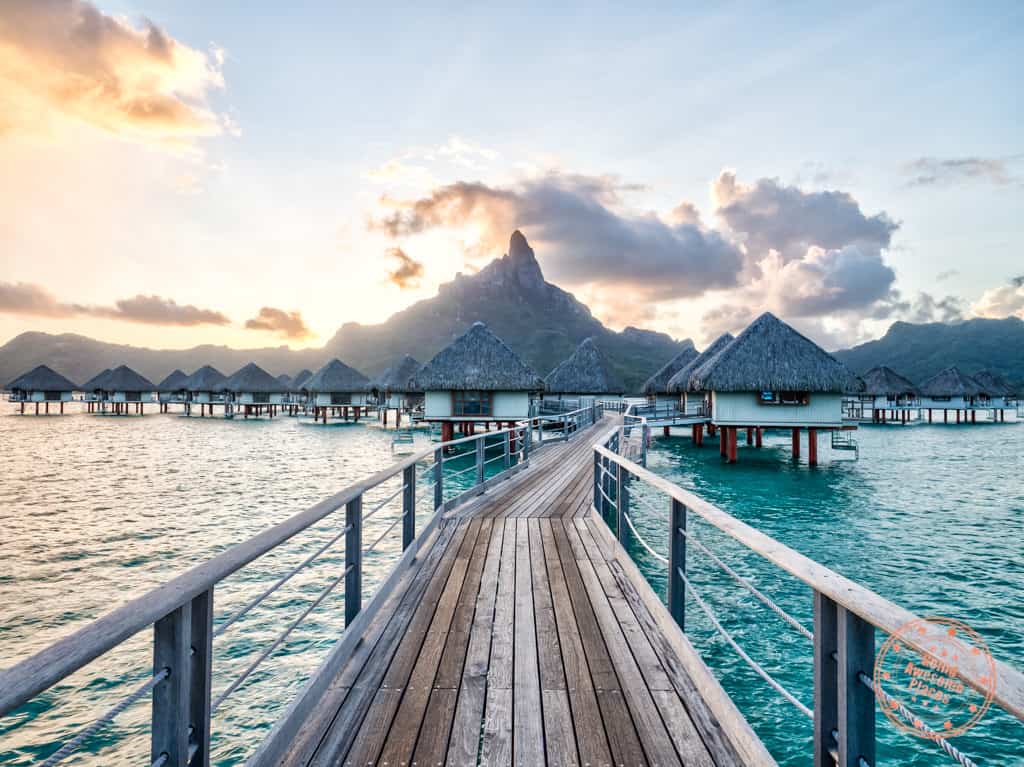
There are so many places to take photos of the resort at sunset but if I had to pick, here are my top locations.
- The left arm of resort by suite 304 has a perfect view of the umbrella of overwater bungalows and Mount Otemanu perfectly aligned in the middle.
- The pool in front of Te Ava restaurant has an unobstructed view of the lagoon and mountain. If you get right down to the water, you can get awesome reflection shots at sunset.
- The Miki Miki Bar has an awesome elevated view of the resort and is definitely a guest favourites to grab a drink and take photos of the sunset.
TOPDIVE Bora Bora
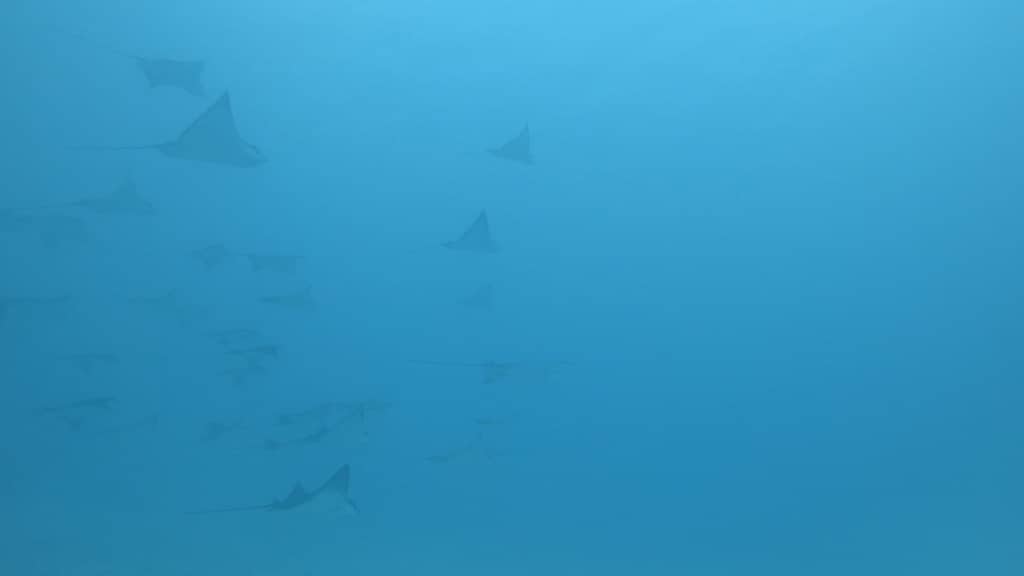
While Bora Bora isn’t necessarily known for the best diving compared to some of the other islands, we were impressed with what we saw during our two tank dive with TOPDIVE.
I can’t guarantee that you’ll see the same thing but our dive with this family of eagle rays was particularly memorable.
Alternatively, there is also a dive centre at the resort named Diveasy where 2 tanks is 25,000 XPF which is slightly higher than TOPDIVE.
WHAT YOU NEED TO KNOW
Address: InterContinental Resort & Thalasso Spa
Hours: Dive times vary but to give you an idea, our pick up time was 8:15AM.
Price:
- 2 tank dive – 19,000 XPF
- 6 dives across all islands in French Polynesia between 2 people – 55,000 XPF
- 10 dives across all islands in French Polynesia between 2 people – 89,000 XPF
FAQ:
- Do they pick ups at all resorts? Yes they will pick you up no matter where you are.
- Is there a cost to rent gear? No, what’s unique in French Polynesia is that all the diving rates are all-inclusive no matter whether you want to rent masks, fins, wet suit, and dive computer.
- What if I haven’t gone diving in over 12 months? They officially do require a refresher if you haven’t gone diving in awhile but it didn’t seem strongly enforced in that they just put you on a regular diving group and provided a bit more guidance on the boat. Otherwise, it’s the same dive that everyone else does.
Tips:
- TOPDIVE in Bora Bora is more full-service which means they have towels on the boat and they provide snacks and beverages in between dives.
- Nitrox is included for free but in Bora Bora it’s not really necessary so it wasn’t provided.
- Typically one dive is in the lagoon and one dive is on the ocean side.
Turtle Center
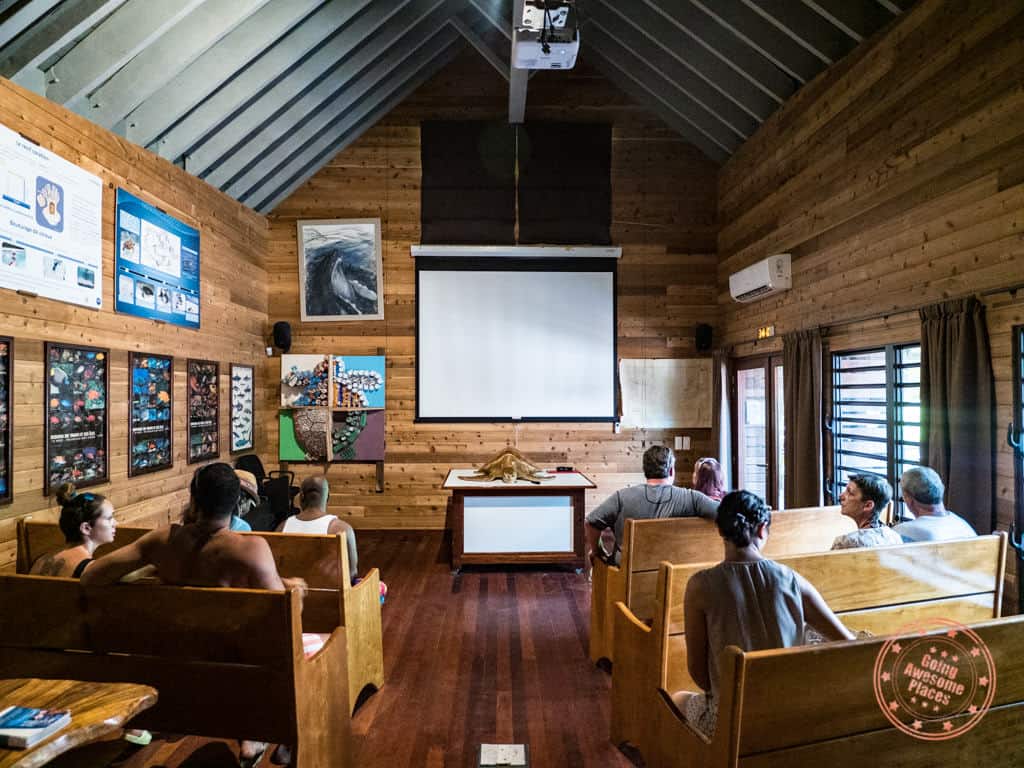

The differentiating feature of Le Meridien Bora Bora is the on-site Turtle Centre. This is an ecological centre dedicated to the conservation and protection of marine turtles. Think of this as a turtle hospital, taking in injured turtles from the region, nurturing them to health, and releasing them back into the ocean when they are ready.
They are exclusively on the property for Le Meridien guests and the best part is that they have a free feeding experience daily that has combines an educational component with a chance to feed turtles that are being rehabilitated in their sanctuary.
WHAT YOU NEED TO KNOW
Address: Le Meridien Bora Bora, 98730, French Polynesia
Hours: Feeding is at 10:30AM daily. Healing hour is daily at 2PM or 3PM.
Price:
- Turtle Feeding – Free
- Healing Hour – 5,000 XPF/person (early reservations recommended)
- Live My Life Healer for a Day – 13,000 XPF per person (t-shirt and lunch included)
FAQ:
- Can I touch the turtles? No this is strictly forbidden for your protection and also to prevent any contamination. Note that you’ll be given gloves to wear to protect the turtles.
- Are cameras allowed? Yes. There are no camera restrictions in the sanctuary.
- How long is the feeding experience? The presentation is roughly 20 minutes and the feeding itself 20 to 30 minutes.
- Is the Healing Hour worth it? If you’re not a scuba diver, this is a great way to swim with turtles.
- Can you openly snorkel in the Turtle Center pool? No, you aren’t allowed to as this is reserved for the Healing Hour activity.
- Can I feed turtles in the Turtle Center pool? There are signs that explicitly say that this isn’t allowed.
Tips:
- The food for the turtles does run out since there’s only a small tupperware box for each turtle so don’t wait.
- The educational component is typically run in English but if there are enough French speakers they do split the group up.
- The souvenir shop has specific hours (Sunday – Thursday 9AM – 2PM) however in reality it’s normally closed since the staff are tending to the turtles and not in the store. The best time to go to the store is right after the feeding experience.
- Throughout the day, they let 1-2 turtles out into the pool as part of their rehabilitation so if you feel like watching turtles, come at any time to see if they’re out and about.
As you can see, there are a ton of things to keep you occupied on the resort itself. If you’re interested in other excursions and/or spending time on the main island of Vaitape, there are also a couple of restaurant recommendations that I can make.
Excursions:
- Half Day 4WD Island Tour – You’ll see several lookouts including East Matira, Faanui Cannons, and Amanahune Bay. See a demonstration by local artists, check out vestiges of World War II, and taste delicious tropical fruits at a plantation.
- Jet Ski and Shark Stingray Snorkel Cruise – Combo tour that includes jet skiing, lunch and snorkelling tour that includes a shark and stingray boat safari.
- Self-Drive Jet Ski Tour – Tour the lagoon in a jet ski on your own with a local guide. Learn how to open a coconut as well in between!
- Morning or Afternoon Snorkelling Tour – Cruise to the best swimming spots throughout the lagoon with your guide and dive beneath the waves
- Stargazing and Sunset Cruise Tour – Following a beautiful sunset, learn about how the ancient Polynesian people used the stars to navigate their way across the South Pacific.
Restaurants:
- Bloody Mary’s – The most popular restaurant on the island that’s known for their fun, beach-vibe environment, and fresh fish. They also provide shuttles for hotels on the island and from dock.
- The Lucky House – Great food and atmosphere and right across from the InterContinental Le Moana.
- Aloe Cafe – A great lunch spot for anyone heading to Vaitape for a day trip. Their poisson cru and tuna burger are excellent.

At the end of the day, my view point is that you’ve spent all of this money to be at a beautiful resort like this so why not enjoy it to its fullest by not planning too much, and enjoy the view and company.
If you want to know the day by day of what I did on the resort, make sure to check out the 16 day French Polynesia itinerary Google Sheet.
Day 4 to 8 Summary
What you’ll see:
What you’ll do:
Where you’ll eat:
- Breakfast – Le Tipanie – Breakfast buffet
- Lunch – Usually skipped – In most cases, we turned breakfast into lunch. If hungry, we ordered room service from the children’s menu.
- Dinner – Te Ava, Miki Miki Bar, and Le Tipanie – There are two main restaurants and one bar at the resort. For best value, Miki Miki Bar is a top choice. For the best food, Te Ava really impressed. Lastly, to save money on some of the nights, think about bringing cup noodles.
Day 9 – Bora Bora to Rangiroa – Real Tahitian Life
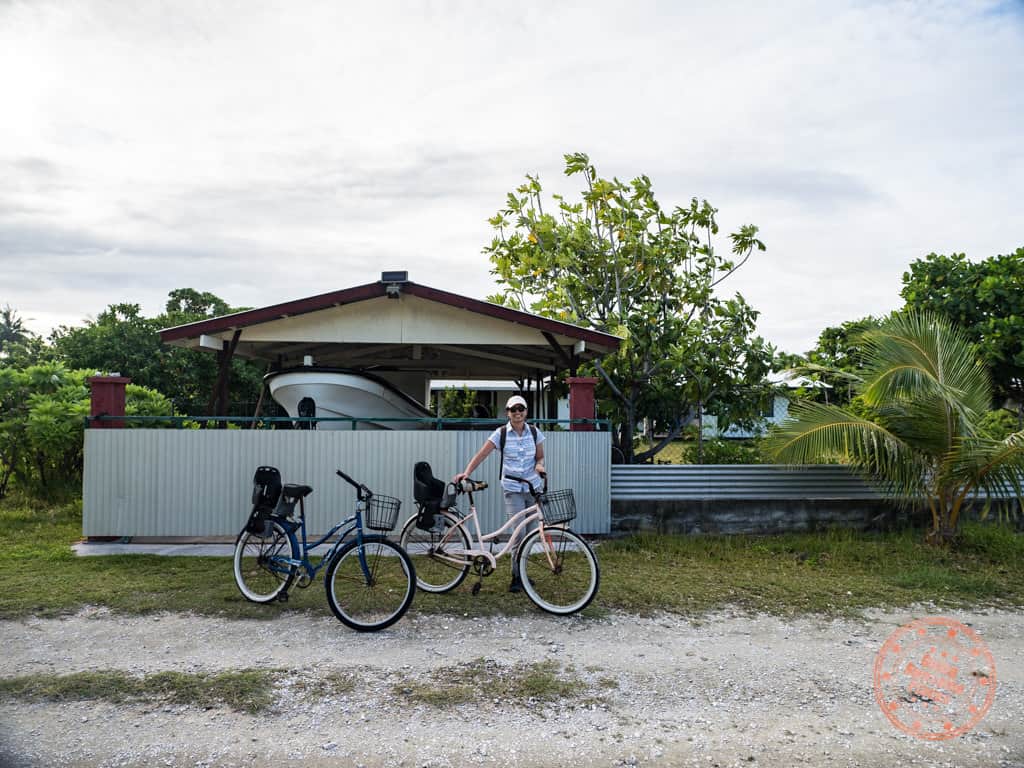
From the Society Islands, you’ll be making your way to the Tuamotu Archipelago which is the constellation of ring-shaped islands better known as atolls that are older in age and teeming with biodiversity. Atolls are essentially a coral reef and land mass that encircles a lagoon through the process of a collapsing volcano.
On your final night, you’ll receive your final bill for your stay and also times for when you need to leave your luggage outside your room and when to gather at the dock for departure. Make sure to double check each line item and if you have any “Make A Green Choice” vouchers (more about these in the resort review), you should get those in the night before. This way, your check-out process should be seamless.

Your boat shuttle will quickly whisk you back to the airport and the check-in process will be incredibly quick. You’ll get your boarding pass, check your bags in, and right beside the counters is the waiting area.
FLIGHT TIP: Remember when I said that Tahiti to Bora Bora was really strict on carry-on weight? Well from Bora Bora, it was the exact opposite. They didn’t check for the number of carry-on pieces or the weight. While we were still trying to stay within limits, it’s safe to say that it is not strict for flying between islands that don’t depart from PPT. Again, no security to worry about.
Bora Bora to Rangiroa is a straight shot 1 hour and 15 minute flight. Similar to Bora Bora, the airport is quite small. Your Tahitian guesthouse should be waiting for you just outside the luggage racks so look out for their sign.

Since you’ll be staying on the Tiputa motu, you will first need a taxi ride to the pier, followed by a short 10 minute ferry by speed boat.
FERRY TIP: This is a small speed boat and is literally just to get you across the Tiputa Pass. There’s no particular schedule for this ferry except it’s every 30 minutes from 6AM to 5PM (with lunch between 12-1PM). The cost is 300 XPF per person and cash only.
You’ll immediately spot differences as you make your way over. Instead of a giant inner island, you’ll see the vastness of the inner lagoon that could easily be mistaken for one of the Great Lakes from your vantage point. Instead of resorts lining up at their airport to greet you with lei’s, you have families, taxi drivers, and the small resorts and guesthouses picking people up.
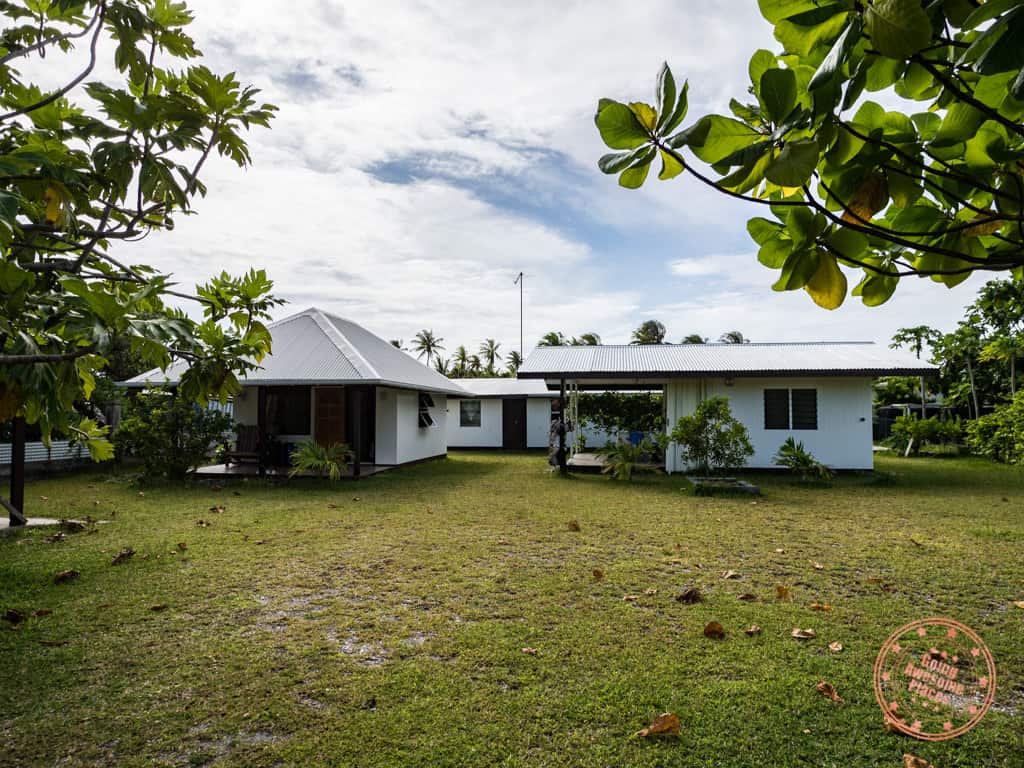
Get settled into your Tahitian guesthouse. Chez Taia et Vero is an extremely affordable property on the Tiputa motu that has the comfort of being in a secluded community while still having the comforts of a private bathroom, strong wifi, free bike rental, and a large shared kitchen.
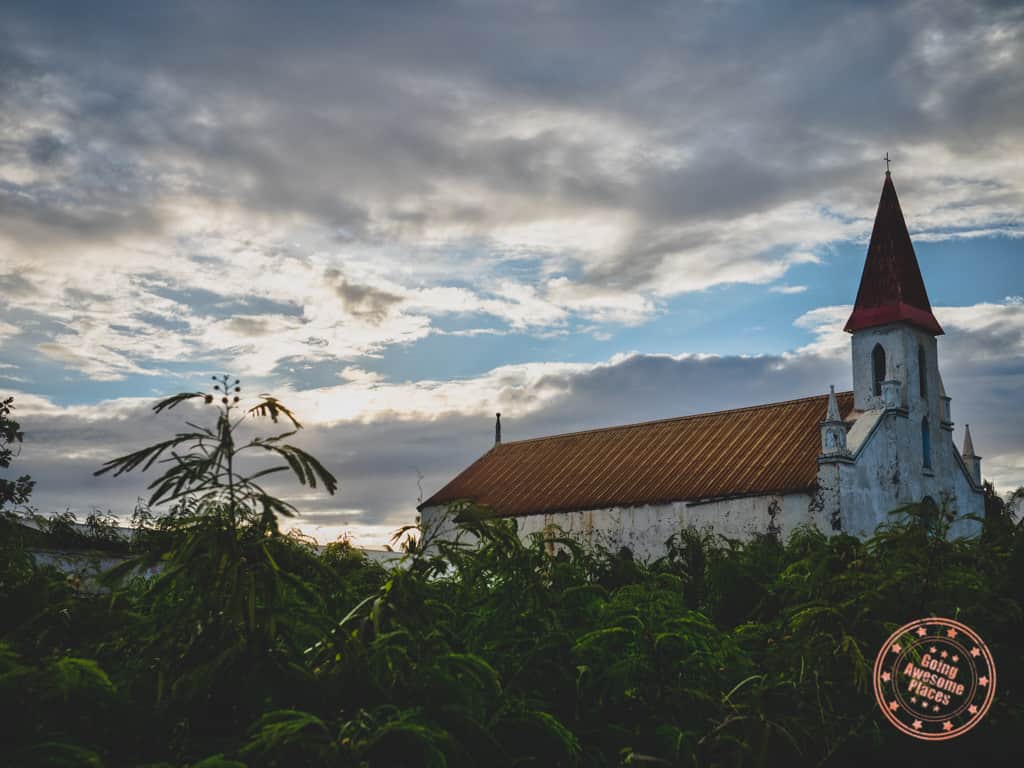
This is the perfect day to go out and pick up supplies that you want for the fridge. There are two convenient stores or magasin as they call them. One is Nova which has better food selection and the other is Ragi which is the only one that sells beer.
Something you’ll need to keep in mind of when planning your supply runs when you’re here is that the the hours of operations are a bit sporadic. Nova is open Monday to Saturday at 5:30AM – 12PM and 3PM – 7PM, and Sunday at 5:30AM – 12PM and 4PM – 7PM. Ragi is open Monday – Saturday at 6AM – 11:30AM and 3PM – 6:30PM. Sundays it’s open 5AM – 8AM.
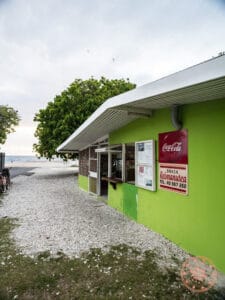
For dinner, you’ll eat at Snack Reimanutea. This is the motu’s only restaurant which sounds crazy but trust me when I say that you’ll quickly appreciate the simple joys of their menu and how your day revolves around their opening hours and ordering schedule.
Heads up that the owner’s English is quite limited so you’ll need to brush up on your French vocabulary or have the Google Translate ready to go.
WHAT YOU NEED TO KNOW
Address: Rangiroa, 98776 Tiputa, French Polynesia
Hours: Monday to Friday 6AM – 2PM and 3:30PM – 5PM.
Menu:

Tips:
- Unofficially, they can open up for eating at the snack shack for dinner if you ask.
- For dinner, you have to put your order in when they are open and request to have it ready for a pick up at 6PM. Alternatively, you can also ask your Tahitian guesthouse to order over the phone for you.
- Their English is quite limited so you might need to have Google Translate running.
- For lunch, they also sell sandwiches on top of the paninis so look out for them.
- They also sell ice cream in the freezer which you can ask for.
- If you missed the opening hours at the convenient store, you can buy Hinano beer here at a slightly higher price.
- You aren’t allowed to bring outside food/drink if you’re eating in.
- The best items on the menu are the Chaud Froid de Thon which is essentially seared tuna and Carpaccio, another classic Tahitian dish with soy-seasoned tuna, capers, tomatoes, and green onions.
Day 9 Summary
Where you’ll eat:
- Breakfast – Le Tipanie – You’ll be able to fit this in before your flight.
- Lunch – Skipped – In the process of getting to Rangiroa, there really isn’t an opportunity to grab food so either pick up some food at the airport or bring your own snacks.
- Dinner – Snack Reimanutea – This is the one and only restaurant on the Tiputa motu. Come here for dinner and either eat in or take away.
Where to stay:
Most properties in Rangiroa are on the Avatoru motu and if I were to do it all over again, I might suggest staying there for reasons of accessibility to more restaurants. However, if you’re looking for a serene and quiet experience with more privacy, the Tiputa motu is still one that I would recommend.
We stayed at Chez Taia et Vero which can be modestly described as bungalows in a family of buildings that belong to the owner. In fact, the owner’s house is right behind. Unlike other Tahitian guesthouses, this one is run more like an Airbnb with more independence to do what you want to do and not be tied to any specific programming. The building’s are located in a hyper-local community outside of even the main village in Tiputa but it is not a beach front property so you do have the adjust your expectations.
It might not be for everyone but we found our basic rooms to be enough for us and we made the most of being able to use the picnic bench and the bench on our unit’s balcony as places to read relax during the height of the afternoon sun. The only thing we did have issues with was the heat in the evening. Luckily a fan is included but we did find it a bit challenging to sleep.
Luckily, I’ve also compiled a list of the top pensions in Rangiroa so make sure you head there as well.
WE STAYED HERE
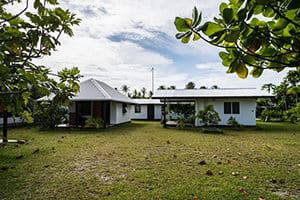
Modest Tahitian guesthouse accommodations amongst a local neighbourhood that is quiet and secluded. Wifi is strong and basic breakfast supplies are provided. Get a real sense of what it’s like to live in Rangiroa here.
TAHITIAN GUESTHOUSE
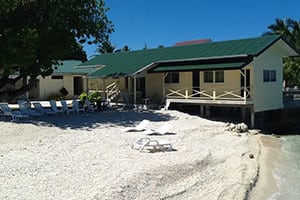
Located in the Avatoru motu and near the airport, this is a beachside guesthouse with shared lounge and kitchen, bbq, free parking, garden, and private beach. Dorms and suites are available.
MID TO UPPER-RANGE
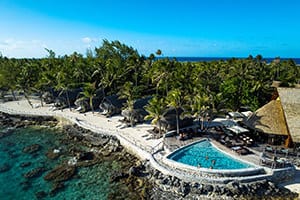
If you fancy living in a Polynesian-style bungalow on the Avatoru motu, this is a perfect resort property that includes a weekly activity program including Poisson Cru show, flower crown presentation, and Tahitian dance lessons.
LUXURY
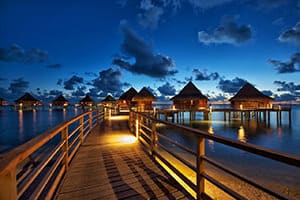
The top property in Rangiroa with a complement of both overwater bungalows, villas with private pools, and beach bungalows. Bordered by white sandy beach and a turquoise lagoon, expect the highest quality of service here.
Day 10 to 12 – Rangiroa – Tiputa Dolphins
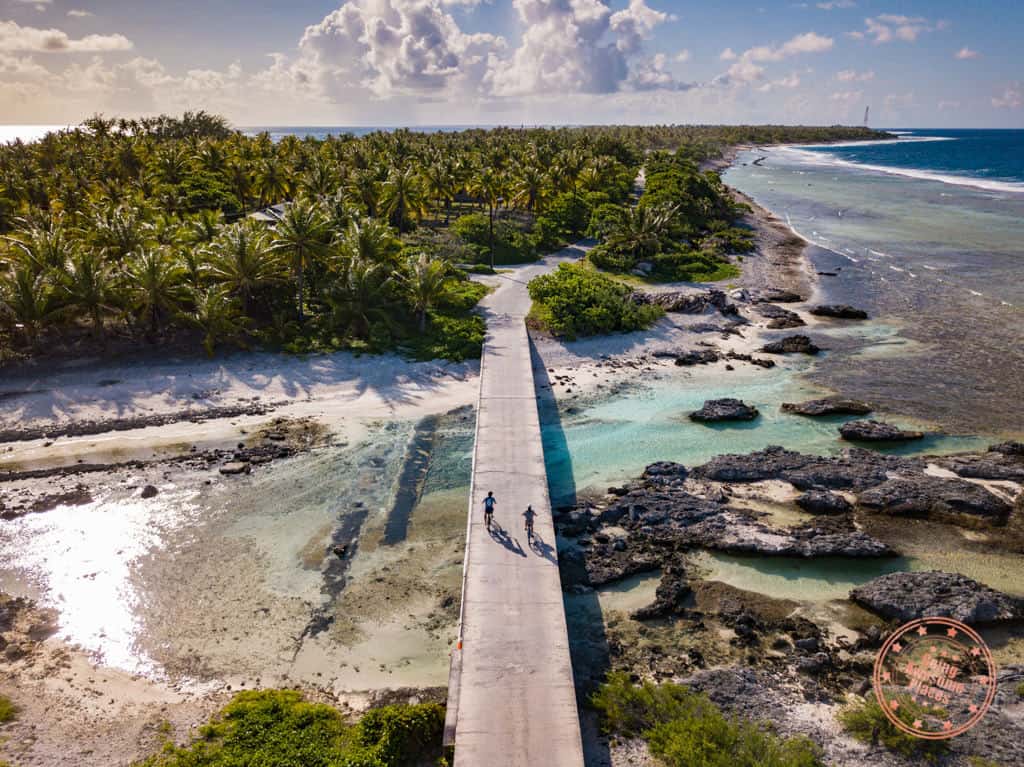
There’s a real sense that this is the real island life in French Polynesia when you get to this part of The Islands of Tahiti itinerary.

On the outside, your Tahitian guesthouse will feel pretty basic but you’ll soon get into the groove of that true island life I was speaking of. It’s the authentic rhythms of your new routine that will be unexpectedly soothing. At the guesthouse, you’ll head down to the inner lagoon and walk along the coral beach, you’ll cook breakfast with the included eggs and baguettes, you’ll hang your laundry, and you’ll read a good book.

When you’re not at the Tahitian guesthouse, you’ll grab your bike, ride into town, and share “ia orana!” hello’s to all the locals you pass by. Along the way, pick up supplies at the convenient store, watch the dolphins at the pass, and then pick up dinner from the snack shack as you head back home.

The atoll is an underwater paradise that’s begging to be explored and it’s through scuba diving that you’ll have the most breathtaking encounters.

For the duration of your 4 nights here, try to fit in as many dives as possible. The company that I recommend is The 6 Passengers.
Something that you need to know about diving here and in Fakarava is that the sites revolve around the passes. These are deep and wide channels where water flows in and out of the lagoon. On Rangiroa, there are two world-class passes.
The most popular pass is Tiputa Pass because it’s home to a pod of 30 dolphins. This means that there is a high probability of seeing dolphins here.
When diving with dolphins, there are 3 things that can happen:
- Sleeping – With one eye closed, you’ll see them gliding by without much fanfare. They will pass through quite quickly in this scenario.
- Playful – Wanting to have fun, they’ll start swimming in between and doing big loops around the diving group.
- Curious – The dolphins will come close either vertically or horizontally and linger. Some may even want their belly scratched.
What makes this experience special is that you’ll have a chance to see dolphins in their natural habitat. The thrill of scuba diving is that no two dives are ever the same. On some dives you might see them pass by in a flash and on another they might decide to come incredibly close.
Pay attention to the sonic sounds that dolphins make to communicate. You’ll initially think it’s a boat passing by or your equipment but you’ll eventually realize the high pitched “hiiiiii-yeah!” sounds are nearby dolphins.

In addition to dolphins, Tiputa Pass is also well-known for its diversity of shark including reef shark, tiger shark, lemon shark, and if you’re lucky, hammerhead shark.
WHAT YOU NEED TO KNOW
Address: Baie de Ohutu, 98775, French Polynesia
Hours: 7:30AM – 4:30PM
Dives are the following times:
- Morning – 7:30AM and 9:30AM
- Afternoon – 2PM
- Sunset – 4PM (minimum of 3 required)
Note that when they say 7:30AM as a dive time, this really means the meeting time at the dive shop. The actual dive itself doesn’t start until an hour later after time to gear up, the dive briefing, and boat ride to the pass.
Price:
- 1-4 dives per person – 8,400 XPF per dive
- 5-9 dives pe person – 7,700 XPF per dive
- 10 or more dives – 7,200 XPF per dive
- 20 or more dives – 7,000 XPF per dive
- Te Moana Pass – 72,000 XPF for 10 dives across all of different centres in French Polynesia and you can share between 2 people
FAQ:
- Do they pick ups at all resorts? Yes, they will do pick ups even if you are staying on the Tiputa motu. A boat will pick you up at the pier and bring you to the dive shop.
- Is there a cost to rent gear? No, what’s unique in French Polynesia is that all the diving rates are all-inclusive no matter whether you want to rent masks, fins, wet suit, and dive computer. Note that if you are borrowing a dive computer, you’ll have to leave behind a piece of ID as a sort of refundable deposit.
- What if I haven’t gone diving in over 12 months? They officially do require a refresher if you haven’t gone diving in awhile but it didn’t seem strongly enforced in that they just put you on a regular diving group and provided a bit more guidance on the boat. Otherwise, it’s the same dive that everyone else does.
- Are reservations required? It is always a good idea as it’s really hard to predict when there might be a large group of divers coming in whether during low or high season. At a minimum, reserve your dives a day in advance.
Good to knows:
- Overall, I found this dive shop to be set up for more experienced divers in mind as there’s minimal introduction and amenities. For instance, I was given a fairly simple tour when arriving and they really leave it up to you to sort out your own gear including getting the things you need to borrow.
- There are no snacks or towels provided by the dive shop so you will need to bring your own. What they do provide is tea, instant coffee, and water.
- They use zodiac-style boats here with no tank racks so what they instruct you to do is to check your gear before leaving the dive shop and then keep the tank in between your legs during the boat ride. Once at the dive location, they’ll help you put the BCD on and you’ll do a back roll entry.
- Since space is limited on the boat, you’re instructed to keep most of your valuables in the cubbies provided at the dive shop. The only other thing you really need to bring on the boat are your camera gear, hat, and sunglasses. Keep these in a dry bag.
- What I recommend that you pack for diving: any of your own equipment, camera, memory cards, batteries, sunglasses, hat, shirt, towel, and dive log. There’s no need to bring water since they have a dispenser.
- Even though I was diving there a couple days in a row, they didn’t offer to keep my equipment together for me to re-use the following days. Instead, I had to ask for new rental gear each day. That said, I definitely saw people using storage compartments at the shop so I know they are available.
- If you’re staying on Tiputa, they can drop you off at the pier after your second tank instead of going back to the dive shop.
- Between the first and second tank of diving, you’ll be taken back to the dive shop to rest so you’re back on solid ground which is great for those that get nauseous easily.
- There are only 4 different dives and only 2 dive sites that they use. One is the Tiputa Pass and the other is the Avatoru Pass.
- Tiputa drift – This is for incoming current
- Tiputa reef – This is for outgoing current
- Sunset – End of day dive at Tiputa Pass right before sunset
- Avatoru reef – This is normally at 7:30AM – You’ll find less of the bigger fish here but the reef profile different and you may spot different marine life. They typically only do this once a week since the boat ride is 30 minutes vs. 10 minutes
- Unlike in Fakarava, they do not time the dives to the current. The dive times are fixed. From my experience, all of the morning dives are outgoing current which is a good thing since this is the best chance to see dolphins.
- One thing I noticed with The 6 Passengers is that they are not afraid to go to the limit on oxygen bar readings. Also, if someone in your group runs low, they were willing to allow that person to use the dive masters secondary regulator. This was not the case for TOPDIVE.
Tips:
- Ask for dive master Serge. Out of all of them, he seems to be the most experienced with the dolphins, meaning your chances of seeing dolphins are higher with him.
- Before you leave the dive shop, make sure to get your dive master stamps which are in the main office. This is also self-serve.

When you’re not diving, there are still other things that you can do on your motu. With your bike, you’ll be able to ride around town and get to a great spot for dolphin watching at Tiputa Pass.
There are two times in the day when you can see dolphins jumping in the water that depend on the changing of currents from inbound to outbound and vice versa. During this transition, the clashing of the water causes standing waves and it’s these waves that the dolphins look to play in.
It will take some patience but it will certainly pay off when they start leaping out of the water in rapid succession on their own, in pairs, or sometimes even in triples.

DOLPHIN TIP: Whether on the Avatoru or Tiputa side of the pass, it’s really about being on the beach at the right time. In the morning, we were able to spot them from 9AM and 10AM. They also seemed to be drawn to the tour boats that came by to watch. In the afternoon, we were told that the tide typically transitions from 4PM-5PM but on the two days we attempted, we had no such luck because the water was so calm.

Since the diving was so good in Rangiroa, it always felt like the alternative boat tour could never live up what we’d be able to see underwater. That said, if you’re looking to change things up over the course of 4 days, here are the activities that I recommend that you check out:
Excursions:
- Reef Island – Discover the lunar landscape of Reef Island which sits on the other side of the lagoon. You’ll have a chance to snorkel here, and learn how to weave. BBQ lunch included.
- Green Lagoon – This is a natural cove that shimmers in emerald green. It’s 5 minutes by boat from Avatoru and you’ll be able to spend the day swimming, snorkelling, kayaking, and paddleboarding.
- Pink Sand Beach – This is a full 8 hour tour because Le Sable Rose is on the far-side of the atoll and is a long boat ride over to the long bank of fine pink sand. It also includes dolphin watching at Tiputa Pass and snorkelling.
- Blue Lagoon and Reef Island Combination – Discover the two essential sites of Rangiroa: the Blue Lagoon and the Reef Island.
Restaurants:
- Chez Lili – Located right at the main pier on Avatoru motu, they serve delicious dishes such as Creole chicken, curry masala with shrimp, and tuna tataki.
- Chez Obélix – From the outside it doesn’t look like much but if you’re staying on Avatoru, you must try their steak frites.
- Te Mao – Popular restaurant with a nice garden setting, nice music, and relaxing environment with tapas-style dishes.
Day 10-12 Summary
What you’ll see:
- Tiputa Pass
- Avatoru Pass
What you’ll do:
Where you’ll eat:
- Breakfast – Tahitian guesthouse – Supplies provided by our guesthouse and also things purchased from the grocery store.
- Lunch – Snack Reimanutea – On some afternoons, you can eat snack bars to save money but otherwise, the restaurant is an easy option after diving to eat-in or buy a sandwich to go.
- Dinner – Snack Reimanutea – While cooking is certainly an option at Chez Taia et Vero, it was just too much hassle so every day after your dive, put a dinner order in and then go back at 6PM to pick up your meal.
Day 13 – Rangiroa to Fakarava – A New Atoll
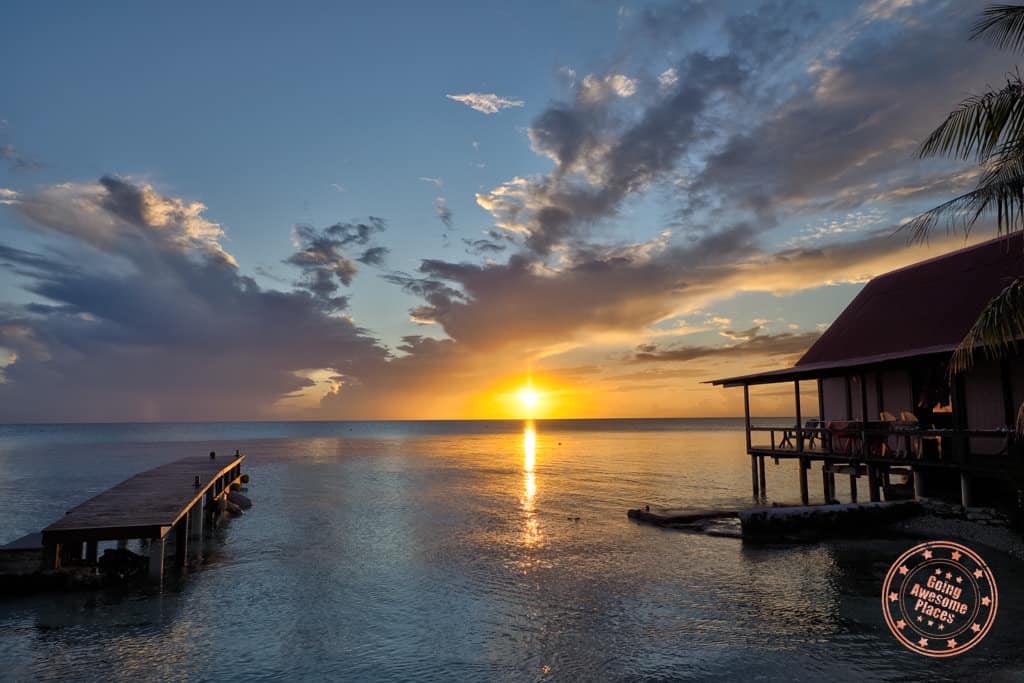
The beauty of French Polynesia is in its abundance of islands. With 118 in total and 3 down so far, you’ve got it in you to do one more. With so many to choose, it’ll feel like an impossible task to pin down your final one. That said, if you’re partial to scuba diving like we are, Fakarava is a solid choice that’s only a short hop away.

With your last day in Rangiroa, you’ll have one last chance to take in the beauty of the atoll and ride out to the motu’s edge to watch the magical dolphin show one last time. Mornings are often the best time to see the dolphins at Tiputa pass.
Since you’ve been spending all of your time on Tiputa motu in Rangiroa, your final day will allow you to have at least one lunch on the other side. Chez Lili is one that comes highly recommended.

Your Tahitian guesthouse will organize a taxi for you from the restaurant and you’ll make it to the airport one hour before takeoff.
FLIGHT TIP: This is another domestic flight and so all the earlier tips apply. As an even smaller airport than Bora Bora, you’ll realistically only need one hour to check-in your bags and get your boarding pass.
A short 45 minutes later on Air Tahiti, you’ll touch down on the Fakarava atoll where you’ll be welcomed by warm greetings by your Tahitian guesthouse host accompanied by leis and tiaré.
Fakarava is the second largest atoll in French Polynesia and uniquely part of a UNESCO biosphere reserve with its 6 neighbouring islands, a testament to the richness of the ecosystem here. Life above and below water here is seemingly unblemished with rare and endemic species, stunning underwater world, and quaint villages that line the road.
Another interesting fact is that Henri Matisse spent 3 months here in 1930 and it is said that Fakarava was the inspiration for “Bleu Matisse”, enthralled by the shades of blue found everywhere.
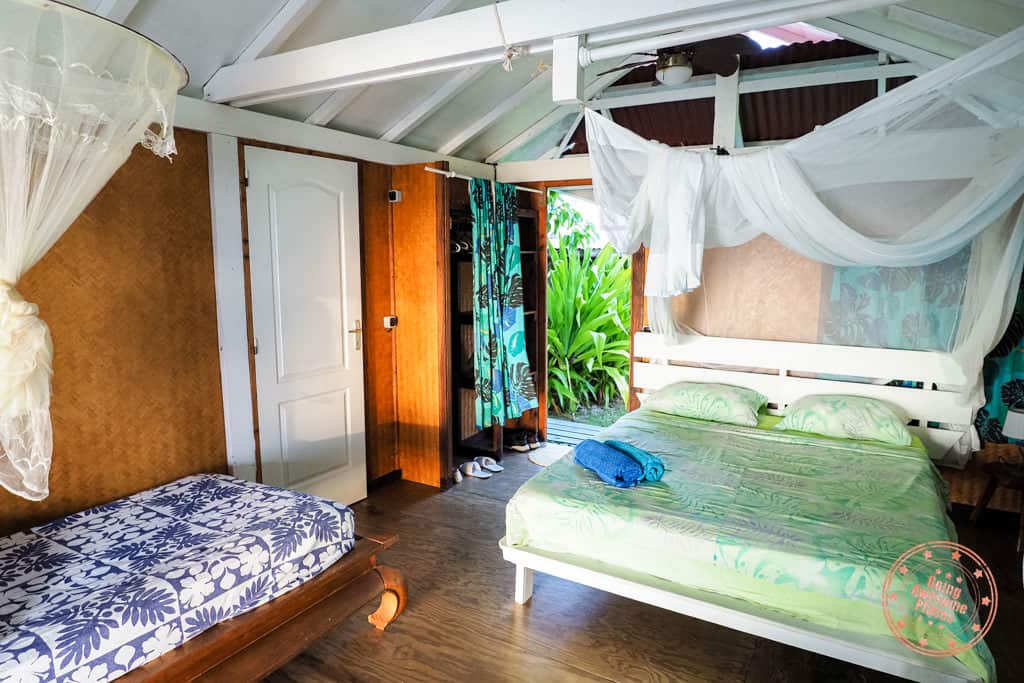
Arriving at Pension Paparara, you’ll spend the rest of the afternoon getting set up in your bungalow and take a tour around the property.
Grab a seat on the pier or the sandy beach and take in the brilliant sunset shimmering over the lagoon.

Beckoned by the ringing of the dinner bell, everyone on the property makes their way over to the guesthouse’s main building. When you arrive, there will be plates upon plates of food which consist of a healthy balance of salad, vegetables, rice, grilled fish, and sashimi. Everything is cooked in their home kitchen and most ingredients are either home grown or freshly caught.
Day 13 Summary
What you’ll see:
- Dolphins at Tiputa Pass
Where you’ll eat:
- Breakfast – Tahitian guesthouse – Supplies provided by our guesthouse and also things purchased from the grocery store.
- Lunch – Chez Lili – A highly ranked restaurant on the Avatoru motu near the main pier, serving dishes with a spicy twist to them including creole chicken and curry masala and the classics such as tataki, carpaccio, and sashimi.
- Dinner – Pension Paparara – Included in your stay are evening meals and so once we got settled into our bungalow, we had an amazing home-cooked Tahitian meal that you’ll be enjoying your entire stay.
Where to stay:
What you’ll quickly learn about Fakarava is that your choices will be limited as this is an even smaller atoll than Rangiroa. On top of that, only Pension Paparara can be booked through a hotel booking platform (Agoda) while everything else can only be found through their own direct websites.
Since pensions dominate the island, you’ll want to head over here to find the best pensions in Fakarava.
My honest review of Pension Paparara is that it is good but has areas of improvement:
- Wifi is available but the signal is only strong enough to cover the lounge/dining area.
- Rental bicycles aren’t included which surprised us. Unless you have activities planned, you’ll feel stuck at the guesthouse since it’s not within walking distance to Rotoava Village.
- They do not have snorkel rentals here so if you don’t bring your own, you’ll be out of luck.
- It might’ve been the time of year we were there but mosquitoes were definitely out in full force here so you really had to be careful with how your mosquito net was set up and needing to use repellent consistently.
- There’s no air condition so your best bet is to move the fan right up to the bed to stay cool.
- The hosts have limited English so communicating was a bit of a struggle despite their friendliness.
I STAYED HERE
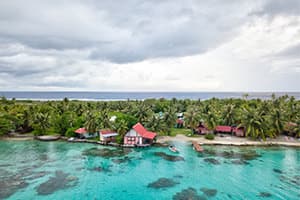
This is a property that is broken up into many small bungalows along the beach, each of varying sizes and some which are en-suite and budget ones that aren’t. Wifi is available but only at the dining/lounge area. Breakfast and dinner is included and bundled in the price.
NEW TAHITIAN GUESTHOUSE
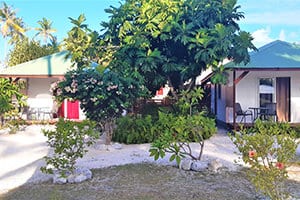
Two new and modernly built bungalows by the beach and located in the village of Rotoava. Rooms are air conditioned which is a key feature. Breakfast, dinner, and round trip airport transfers are included.
CLASSIC GUESTHOUSE
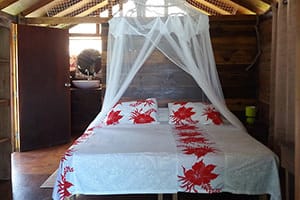
All-inclusive family guesthouse that is right by a sandy beach and fringed by coconut palm trees that includes breakfast and dinner.. There are 6 bungalows total and 4 types. Airport transfers are not included but they do include bikes, kayaks, and a visit to a pearl farm.
RESORT

This is the only proper resort with a collection and beach and garden bungalows, a full restaurant, gym, bikes, kayaks and canoe, snorkels/fins, table tennis, table football, and library. Being an old pearl farm, there’s also a chance to visit a pearl farm and open an oyster as well. Units all have air condition.
Day 14 to 15 – Fakarava – Wall of Shark


Simply put, Fakarava is an immersive world of diverse coral and marine life and to not scuba dive would surely be a shame.
Start your day off with a breakfast at your Tahitian guesthouse which will be ready for you at the table whenever you’re ready. You’ll have your mix of fruit, baguettes, spread, yogurt, coffee, and tea each morning.

For your two full days on the atoll as part of The Islands of Tahiti itinerary, plan on spending most of your time out in the water and diving with an outfit such as TOPDIVE.
There are two distinctive areas where you will be scuba diving, the pass in the north and the other in the south. Each of these passes are the inlet and outlet of water that connects the lagoon to the ocean. It’s during this inhale and exhale of water where big fish congregate to create this richly covered seascape.

The North Pass is known as Garuae Pass and is the most easy to get to since it is not far from TOPDIVE and the main village. Your dives here will be marked by an incredible mix of wildlife that will rival what you can see in Rangiroa. Common sighings here are the big Napoleons, school of barracudas, jackfish, marbled groupers, and shoals of yellow goatfish that slice through the water between the garden of coral. Of course, the big show belongs to the countless number of grey shark that patrol the pass.


The South Pass is known as Tetamanu Pass and is less frequented by dive shops in the north because of its distance but is even more a must-do because of a phenomenon known as the “Wall of Shark”. While at the edges of the pass, you’re either drifting with the current or planting yourself on the side banks of coral and playing out in a scene before you has to be the largest concentration of shark you’ve ever seen. The horizon of blue is literally stamped with shark fins either fighting the current or gliding by.
For dives in either location, you’ll learn that entry is meticulously timed to something known as a slack tide when there is a short window where the current is neither inbound or outbound and the water is completely unstressed. Alternatively, they can also look for a full transition into an inbound or outbound of tides. This is very different from Rangiroa where dive times are fixed.
WHAT YOU NEED TO KNOW
Address: White Sand Beach Resort, BP174, 98763, French Polynesia
Hours: 8AM – 5PM. Dives times are not fixed here as it is highly dependent on tides. Here’s an example of our dive times:
- North Pass – Pick up at 10AM, Dive 1 at 11:18AM, Dive 2 at 2:09PM
- South Pass – Pick up at 7:40AM, Dive 1 at 10:06AM, Dive 2 at 2:39PM
Price:
- 2 tank dive – 19,000 XPF
- 6 dives across all islands in French Polynesia between 2 people – 55,000 XPF
- 10 dives across all islands in French Polynesia between 2 people – 89,000 XPF
- Supplement for Fakarava South Pass (lunch and boat ride) – 33,000 XPF
- Supplement for Fakarava South Pass if you’re on a pass – 12,500 XPF
FAQ:
- Do they pick ups at all resorts? Yes, as long as they can drive out to your resort, they’ll send someone to fetch you by van.
- Is there a cost to rent gear? No, just like any other dive shop in French Polynesia.
- Are reservations required? It’s a good idea to reserve at least a day in advance as it goes into their staff planning.
Good to knows:
- Unlike in Bora Bora with TOPDIVE, Nitrox is used on all dives here at no extra cost, no matter whether you’re certified or not.
- If you plan on diving at other TOPDIVE centres in French Polynesia, they’ll issue you a Nitrox certificate that is only good at TOPDIVE.
- For dives in the north pass, you need to pack your own lunch.
- For dives in the south pass, a supplement charge is required because this includes lunch at Motu Aito Paradise and the boat ride is 1 hour there and back depending on the water conditions.
- North Pass is also known as The Garuae Pass. South Pass is also known as Tetamanu Pass.
- The TOPDIVE shop has a change area, bathroom, cubbies to store personal items, and a water dispenser.
Tips:
- Towels are provided at the dive shop and at the south pass lunch spot but not in the north pass.
- Diving the south pass is not common so if you are keen on it, you should let them know ahead of time to see if they can form a large enough group that’s willing to go. While there’s no fixed schedule, it’s safe to assume that they only go to the south once or twice a week.
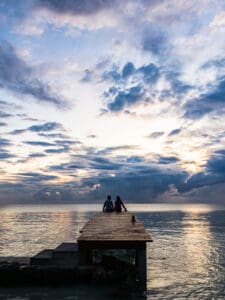
Scuba diving in Fakarava tends to take the whole day since it is so dependent on timing of tides so you’ll find that by the time you get back to the resort, you’ll have enough time to get changed and catch the sunset before it’s dinner time again.
If scuba diving is not your thing, there are alternative activities you can consider:
Excursions:
- Quad Excursion – Explore the north of Fakarava in a 2 hour 4×4 experience to see the island’s heritage and the beauty of its nature.
- Jet Ski Tour – A 1.5 hour jet ski excursion that includes pick up from your accommodations and offers a thrilling way to discover the atoll.
- Private 3.5-Hour Boat Excursion – Completely private and customizable experience where you can go snorkelling, visit a faraway beach, and also learn about the underwater ecosystem. This is perfect for a family of up to 3 people.
Restaurants:
- Snack Kori Kori – One of the best snack bars on the island and perfect for lunch. Meal sizes are good, and service is good and quick.
- Havaiki le Restaurant – This restaurant is part of the Havaiki Lodge Resort in Fakarava but is open to the public as well.
- Snack Chez Elda – Casual lagoon-side snack bar with dishes such as sashimi, tartare, and poisson cru. They also offer free pick up and return.
Day 14-15 Summary
What you’ll see:
- North Pass
- South Pass
What you’ll do:
Where you’ll eat:
- Breakfast – Pension Paparara – A full breakfast provided by the property.
- Lunch – Sandwiches to-go or lunch at Motu Aito Paradise in the South Pass.
- Dinner – Pension Paparara – Incredible Tahitian meals served every evening.
Day 16 – Home – Back to Reality

All good things must come to an end. With your glowing tan, eyes wide open from close encounters with sharks, relaxed from the peaceful lifestyle, and experiences of paradise, you’ll be sad to leave but comforted that you’ve seen some of the best that The Islands of Tahiti has to offer.

The journey home will be a long way and it starts with wrapping things up in Fakarava first. You’ll have breakfast at your Tahitian guesthouse. With some free time in the morning, make use of the wifi at the lounge, take the kayak out, or hang out in your bungalow.
TIP: Before you leave your guesthouse, shower one last time to stay as fresh as possible for your upcoming flights.

Your first leg will have you fly from Fakarava to Tahiti which is just a tad over an hour.
When you land at Faa’a International Airport in Tahiti, you’ll exit out of the domestic side of the airport. This puts you right out into the main open area of the airport. If you’ve rented a hotspot from Tahiti Wifi, this is your chance to return it. There is also a mailbox here so this is also your last chance to mail out any postcards.

If you have a lot of time in between landing and your international flight home, you can take advantage of the luggage storage facility or book a Roulottes activity to have one final meal in Papeete.
For those that don’t have time in between, head over to the international airline counter (far right side of the airport) to get your boarding pass and check-in your luggage.
TIP: The doors to the international terminal don’t open until 6PM so you’ll find many people congregating around the sliding doors. This means that even if you check-in early, you won’t be able to head into the gate or lounge earlier than 6PM.
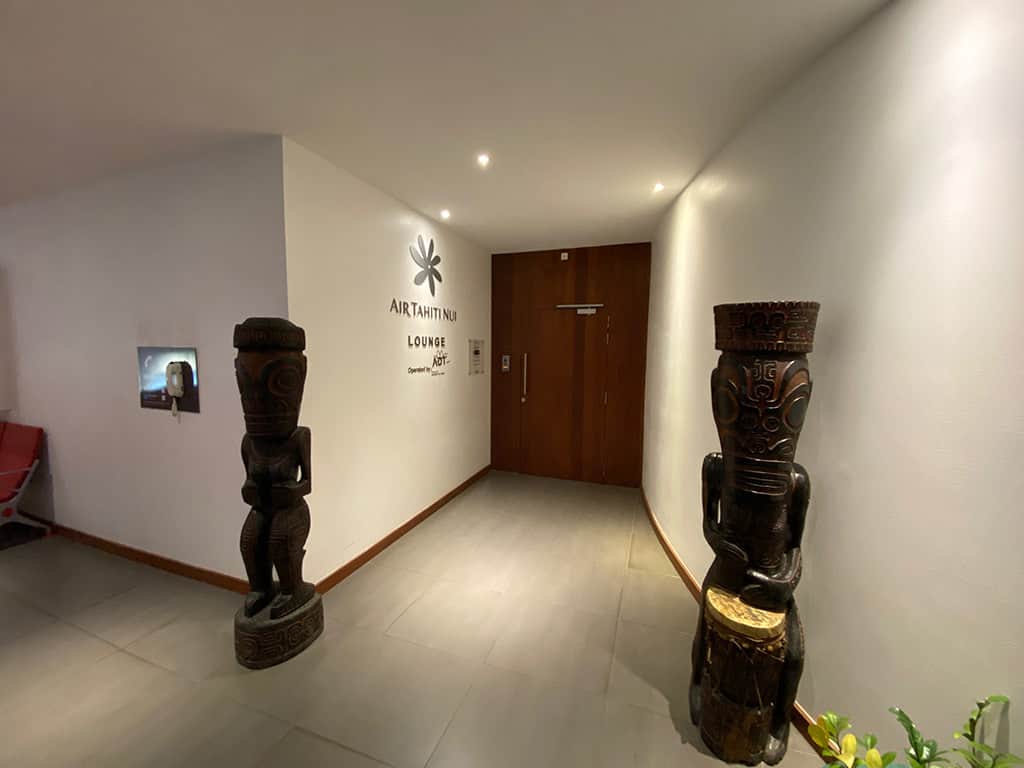
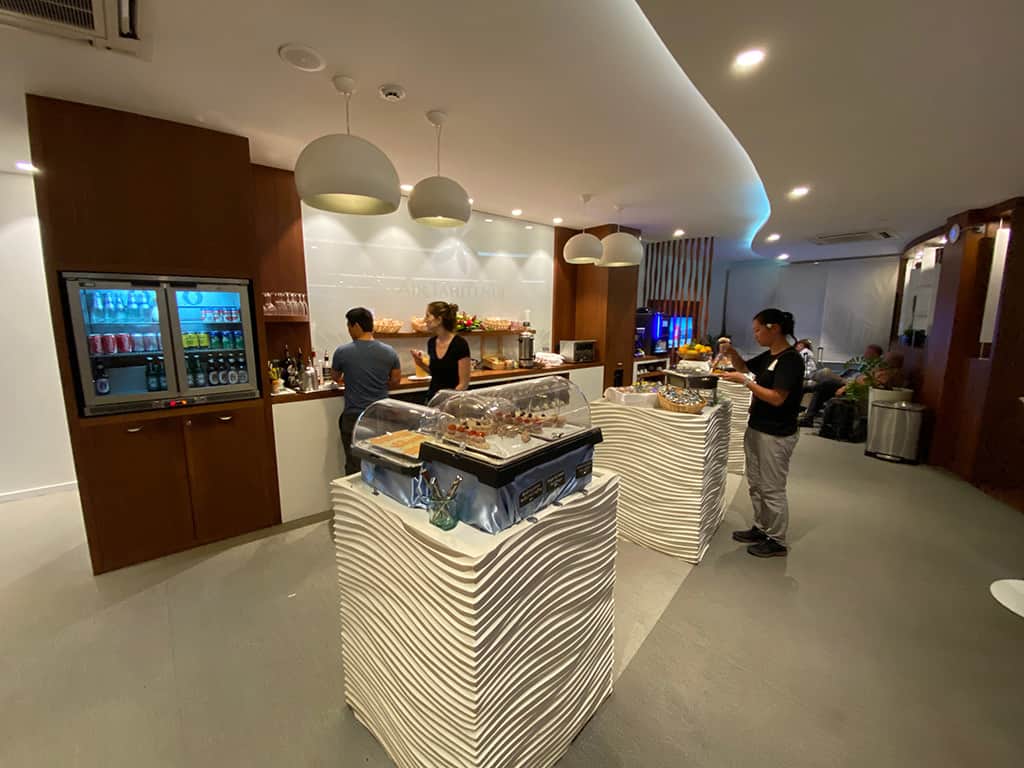
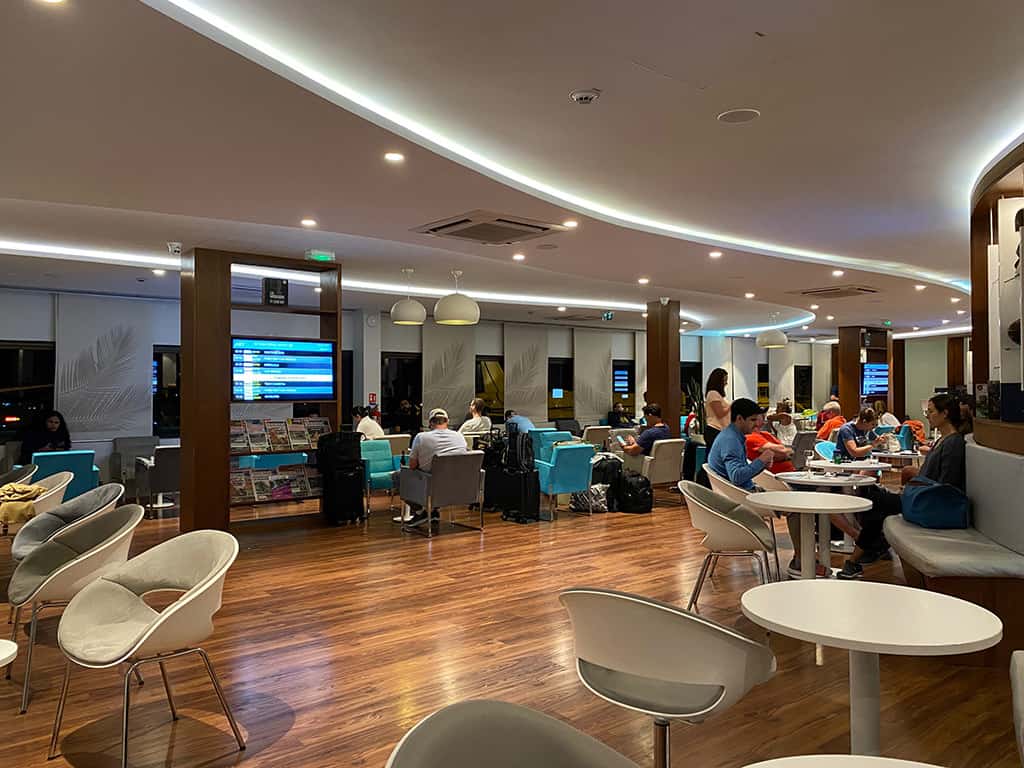
For those that have Priority Pass through something like the American Express Business Platinum or Scotiabank Passport Visa Infinite, you’ll be happy to know that the Air Tahiti Nui Lounge is affiliated so you’ll be able to take advantage of their wide selection of food, drinks, and showers as well.

When you’re all set, head down to the gates prior to boarding time and say “maururu” one last time.
Day 16 Summary
Where you’ll eat:
- Breakfast – Pension Paparara – A full breakfast provided by your Tahitian guesthouse.
- Lunch – Skipped – There really was no opportunity to eat transiting from Fakarava to Tahiti so we just made sure we ate well for breakfast.
- Dinner – Air Tahiti Nui Lounge – This is the lounge on the international gates side of the PPT. The great thing about this lounge is that they’re also a Priority Pass lounge so if you’re a cardholder, you’ll be able to take advantage.
Quick French Polynesia Travel Guide
This is a condensed version of the full guide that you’ll find in the Comprehensive French Polynesia Trip Planning Guide which includes topics such as The Islands of Tahiti itinerary trip costs, cost saving tips, how to pick which islands to go to, and more. Here are basic topics and answers that’ll get you started.
Money – The local currency in French Polynesia is the Pacific Franc or XPF. This is a difficult to obtain currency in most countries however you can put an order in with a large and central bank if one is convenient to you. For most people, it’ll make the most sense to exchange for XPF when you arrive. This may seem like an easy task however depending on your approach, it can get complicated. The easiest place to exchange currency is right at the airport. There is an exchange office here and it is open on weekends however keep in mind that each transaction has a fee of 700 XPF. There is also a maximum of 500 EUR. Alternatively you can go to the bank but keep in mind they do not open on weekends and only central banks in Papeete carry cash on hand. We learned the hard way that smaller banks in neighbouring towns don’t carry cash. Lastly, there’s the ATM option if you’d prefer to pull money from your debit account. For this, beware that not all ATMs are foreign card friendly and the maximum withdrawal limit is around 30,000 XPF.
When is the best time? – There is no real bad time to go to French Polynesia as temperature averages are always in the high 20C/70F’s. What changes throughout the year is whether it is rainy season or not. Precipitation is high between the months of November to March. While this may seem like a bad thing, this coincides with the country’s low-season for travellers. For the absolute best in weather, June to September is the most ideal as they are the driest and coolest as you also have to remember that the country is located south of the equator.
Getting here – The primary international airport for French Polynesia is on The Islands of Tahiti with the name Faa’a International Airport (PPT). International flights are serviced by Air Tahiti Nui (national carrier), Air Tahiti, United Airlines, Air France, French Bee, Hawaiian Airlines, Air Calin, and Air New Zealand.
How do I get around? – For islands that are close to each other, ferry services are available for instance between Tahiti and Moorea however, most travellers will likely be flying between islands. The only airline that services all of The Islands of Tahiti is Air Tahiti.
Where should I stay? – I’ve listed all of the recommended accommodations above but in general when it comes to where to stay in French Polynesia, Booking.com is going to be your best bet to find not only the big brands but also the more affordable Tahitian guesthouses with the benefit of a great cancellation policy and also Genius level discounts whether for Tahiti, Bora Bora, or Rangiroa. Fakarava is an exception here as there is not much inventory on booking platforms. As an alternative, there’s also Expedia and Airbnb.
Do I need travel insurance? – As always, travel insurance is highly recommended. My philosophy is that you want to make sure you’re covered in case the unknown happens. With the amount of travel that I do, I always get basic travel insurance that’s good for multiple trips and lasts the full year. World Nomads is always a great one to consider no matter where you’re from. Make sure to read my full review of why and a breakdown of how they work. For a more broader look at travel insurance, make sure to read this.
The Islands of Tahiti Itinerary Experience
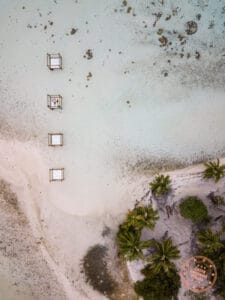
I’ve been spending a great amount of time putting together this itinerary and at the same time thinking about the words to describe our time in French Polynesia.
Something that I learned while I was out there was something Tahitians call, Mana, the power of life and spirit of the islands. It’s not specifically one thing, or even something that you can touch. It’s that tingly feeling you get when that humid breeze hits you for the first time when you step off the plane, when locals wave “ia orana” as you pass by, the uplifting music of the ukulele, and calm of relaxation that fills the soul.
Our trip was unlike anything else we’ve done before. In one hand, we had an experience that felt like the cemtre of the romantic universe where we were pampered with luxuries. We then had another experience where we had a much more rugged experience, welcomed to the daily fabric of life, and experiencing a deeper connection to what it’s like to live in The Islands of Tahiti while also discovering the wonders below the ocean. Both were dynamically different but powerfully memorable.
Got questions for your own classic trip to French Polynesia and The Islands of Tahiti? Let me help by simply dropping a comment down below!
What you should read next
Travel Resources For Your Next Trip
If you’re in the process of planning your trip and putting together your itinerary, these are genuinely the best resources that the Going Awesome Places team stands by 100%.
Credit cards: Don’t get burned by hidden fees on top of terrible exchange rates. When we travel now, we use the Wise Card. Simply load it with the currency you need before you go and use it as a regular VISA or their digital wallet card. Use their free app to track how much you have and top up when you need to.
Flights: Of all the booking search engines, Skyscanner is the most helpful and easy to use thanks to their Everywhere feature. Kayak is also another that’s we will often check as well.
Car Rental: If you’re looking to save money, these car rental coupon codes will be a true game-changer. Otherwise, DiscoverCars and RentalCars are great places to start.
Airport Parking: You’ll need a spot to leave your car at the airport so why not book a spot at a discount. Use code AWESOME7 to get at least $5 off at Airport Parking Reservations or Park Sleep Fly packages.
Data: We’ve been a huge fan of wifi hotspot devices like PokeFi because their rates are so good and you can use it globally but recently, we’ve really loved using eSIMs. The best one is Airalo. Save money by getting region-specific eSIMs and use referral code WILLIA9500 to get $3 USD credit on your first purchase. Ubigi is another one that we’ve had success with where they uniquely offer 5G coverage. Use code AWESOME10 to save 10% on your first order.
Hotels: Our go-to is Booking.com because they have the best inventory of properties including hotels and B&Bs plus they have their Genius tier discounts. The exception is Asia where Agoda always has the best prices. TripAdvisor is also useful for reviews and bookings.
Vacation Rentals: Your first instinct will be to check Airbnb but we always recommend checking VRBO as well if you’re looking for a vacation rental.
Tours: When planning our trips, we always check both Viator and GetYourGuide to at least see what’s out there in the destination that we’re going to. They often have different offerings and prices so check both.
Travel Insurance: Learn how to buy the best travel insurance for you. This isn’t something you want to travel without.
- Insured Nomads – Popular insurance provider for frequent travelers and comes with great coverage and special perks.
- RATESDOTCA – Search engine Canadians looking for the cheapest insurance including multi-trip annual policies.
- SafetyWing – A perfect fit for long-term nomads.
- Medjet – Global air medical transportation.
- InsureMyTrip – Best for seniors, families, and those with pre-existing conditions.
If you need more help planning your trip, make sure to check out our Travel Toolbox where we highlight all of the gear, resources, and tools we use when traveling.
